


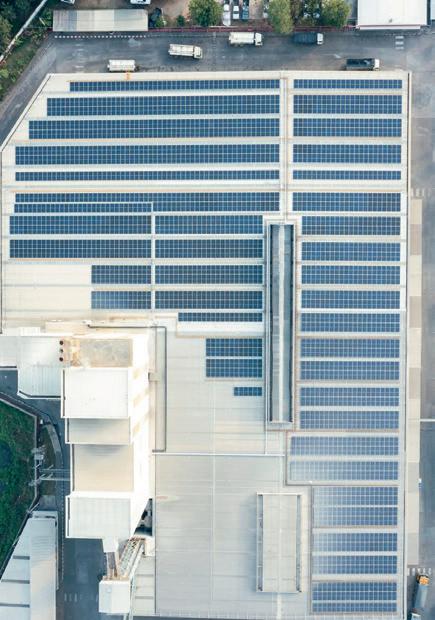
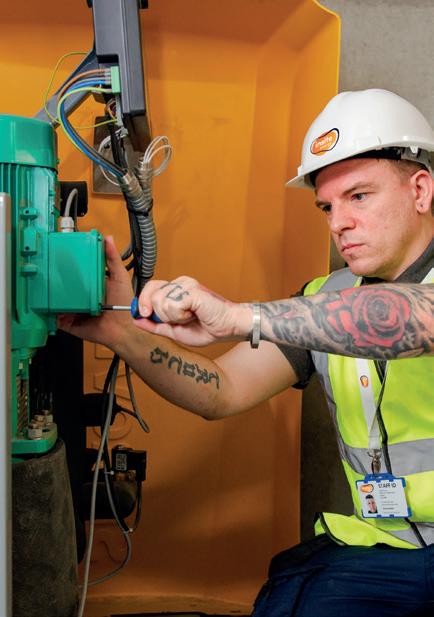
Power Quality Issues – Part 5 – Reactive Power and Power Factor 16 Rinnai delivers hot water at Scarborough Care Home 23 Keeping Commercial Heating Systems Clean 24 Which technology is best at reducing energy costs? 16 The green revolution: Taming the energy beast 12 Heat network regulation changes –what you need to know 37 www.energymanagermagazine.co.uk MARCH 2024
THIS ISSUE: THE NEED FOR ENVIRONMENTAL ACCOUNTABILITY THROUGHOUT THE SUPPLY CHAIN
page 8
INSIDE
See
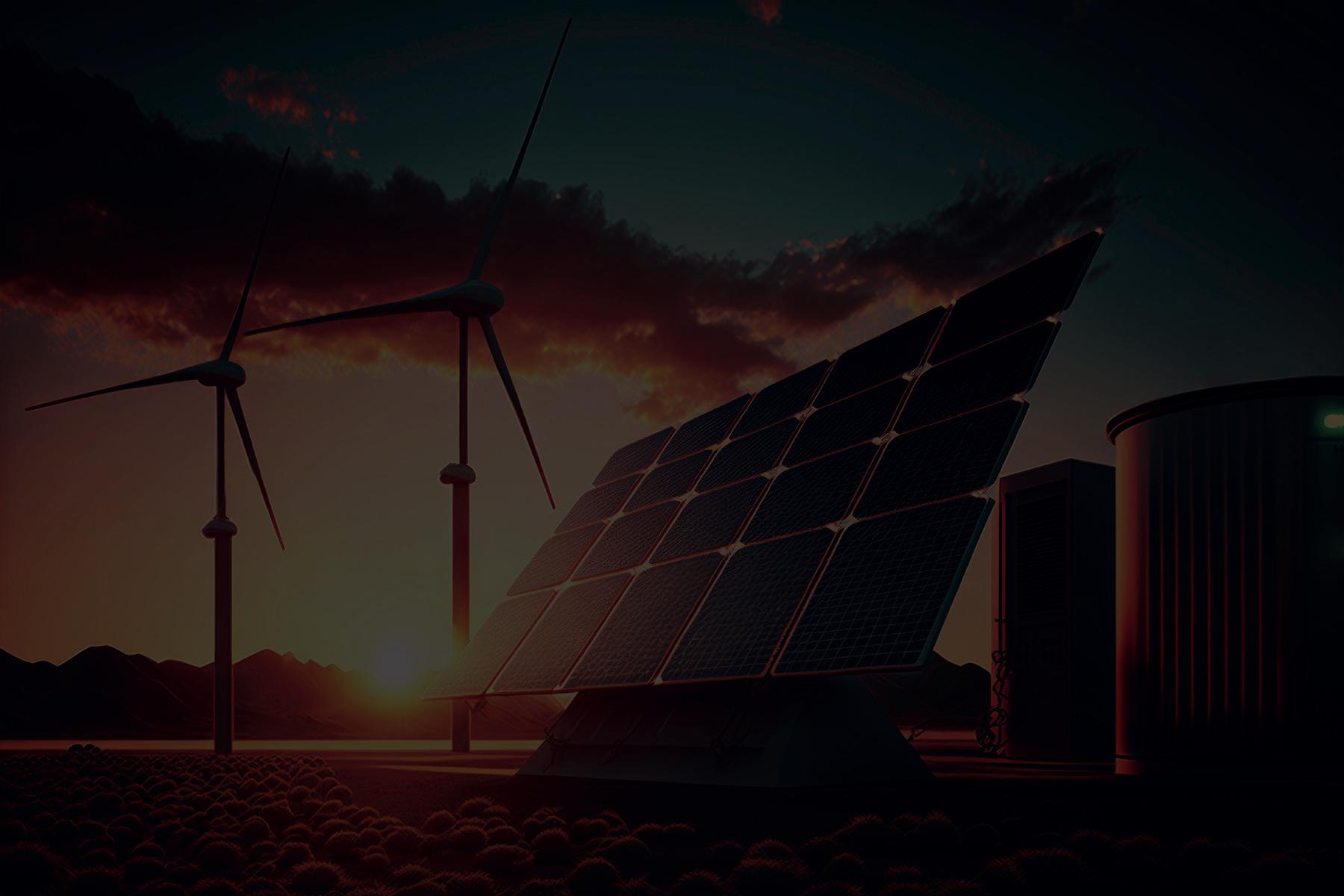
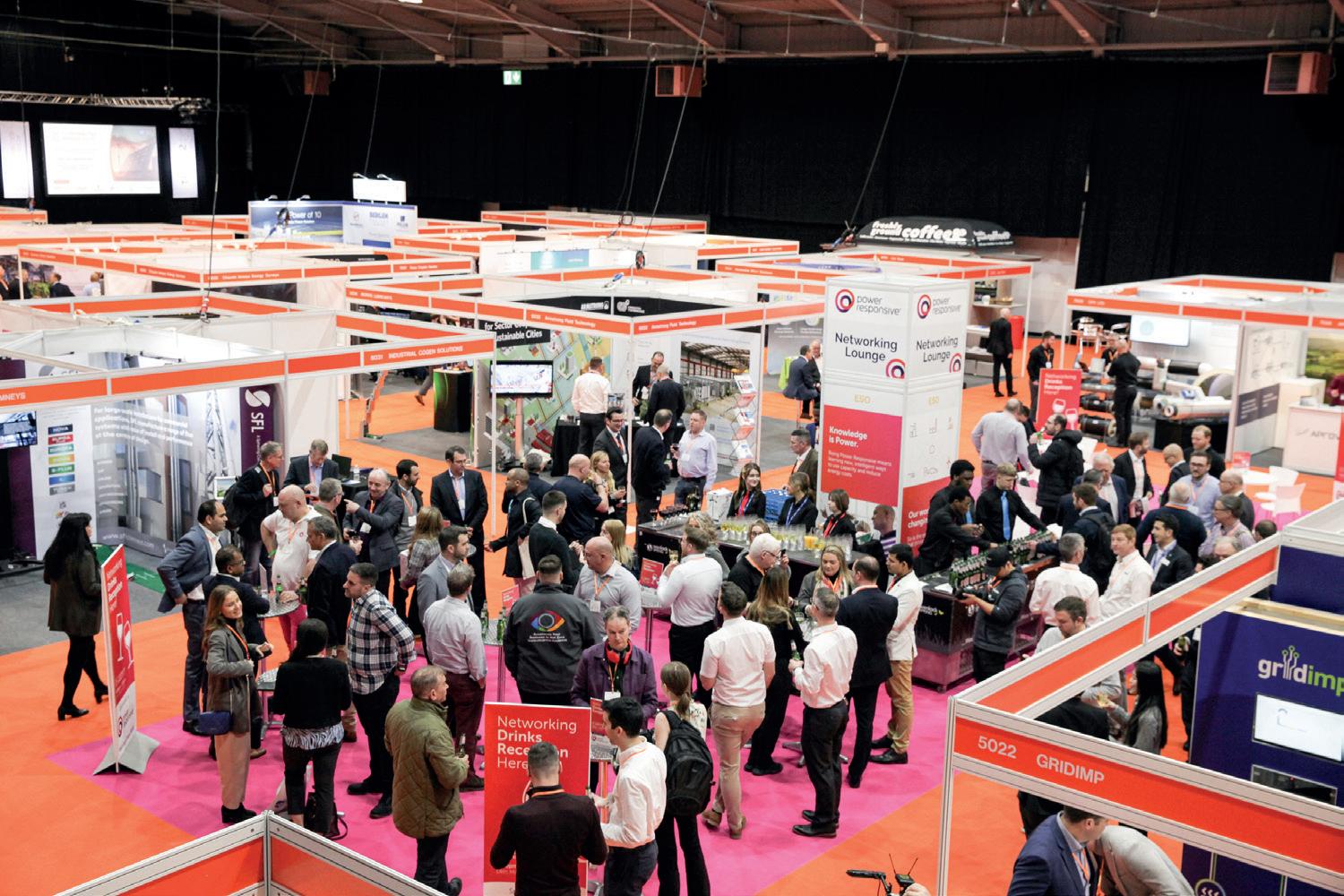
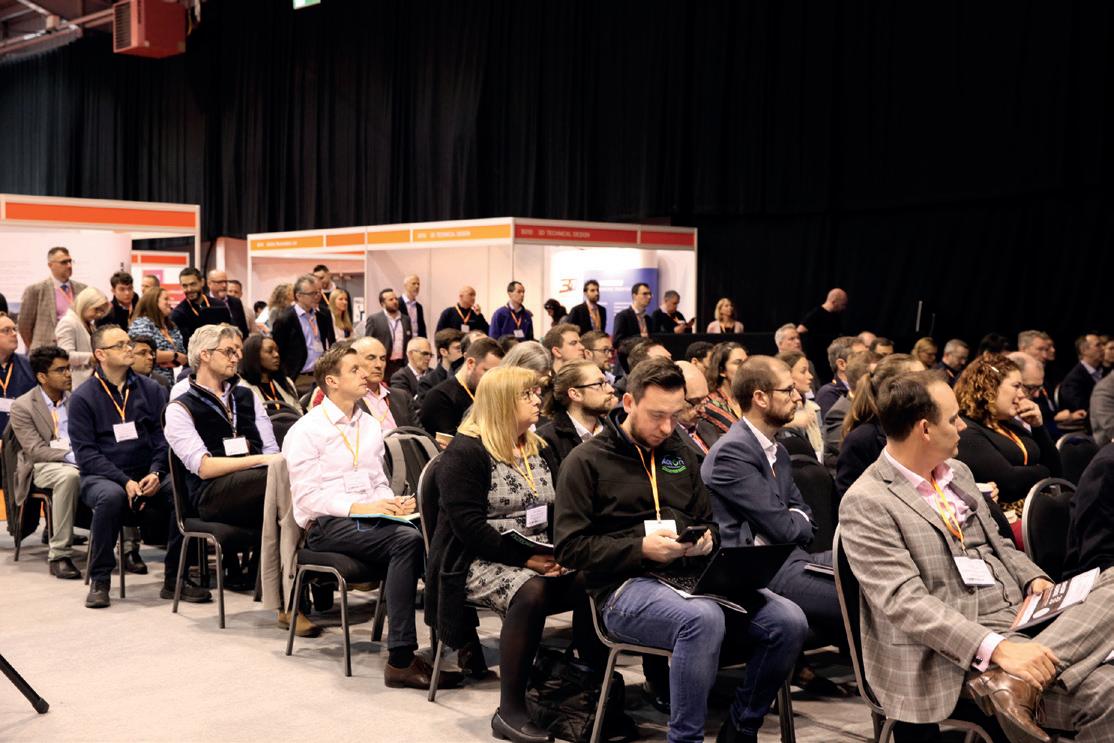















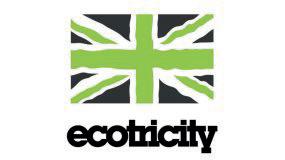


Conference Topics Include: Industrial Decarbonisation Energy Flexibility Power Infrastructure/Generation Net Zero Targets Local Energy Systems And much more! Discover the latest technologies for flexible and onsite energy solutions 13th & 14th March 2024 Telford International Centre, Telford, UK Join 120+ leading technology suppliers including: Sponsored By: Scan this QR code or go to www.distributedenergyshow.com • #DES24 Register for free

MARCH 2024
PUBLISHER: Ralph Scrivens ralph@ energymanagermagazine.co.uk
PRODUCTION: Sarah Daviner sarah@ energymanagermagazine.co.uk
ACCOUNTS: accounts@ energymanagermagazine.co.uk
PRINT: Mixam Print
ENERGY MANAGER MAGAZINE is published 10 times a year by Energy Manager.
www.energymanagermagazine.co.uk
42 Wymington Park, Rushden, Northants, NN10 9JP
Email: mail@energymanagermagazine.co.uk
REGISTRATION: Qualifying readers receive Energy Manager free of charge. The annual subscription rate is £80 in the UK, £95 for mainland Europe and £115 for the rest of the world.
Single copies £10.
Some manufacturers and suppliers have made a contribution toward the cost of reproducing some photographs in Energy Manager.
PAPER USED TO PRODUCE THIS MAGAZINE IS SOURCED FROM SUSTAINABLE FORESTS.
Please Note:
No part of this publication may be reproduced by any means without prior permission from the publishers. The publishers do not accept any responsibility for, or necessarily agree with, any views expressed in articles, letters or supplied advertisements.
All contents © Energy Manager Magazine 2024 ISSN
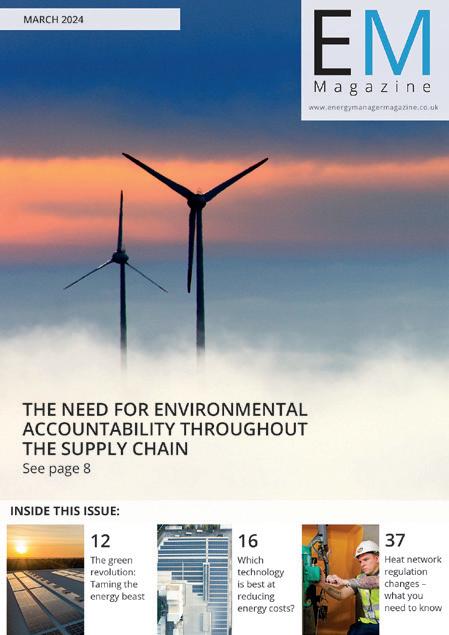
2057-5912 (Print) ISSN 2057-5920 (Online) INSIDE ENERGY MANAGER MAGAZINE • MARCH 2024 3 4 News 8 Cover Story 10 Energy Management 19 EV Charging 20 Opinion 22 Water Management 25 Heat Pumps 30 Energy Procurement 32 Energy Finance 35 Net Zero 36 Heating 37 Heat Networks 38 On-site Generation 39 Carbon Accounting The need for environmental accountability throughout the supply chain FRONT COVER STORY: See page 8

SLEEPING ENERGY MODELS HOLD THE KEY TO CLOSING THE PERFORMANCE GAP

Industry whitepaper reveals the untapped potential of dormant digital assets
Reinstating existing 3D design, energy compliance or BIM models created during a building’s development is instrumental in closing the gap between a building’s predicted and actual operational energy performance, according to experts from across the built environment sector.
A landmark collaborative whitepaper published by Glasgow-based climate technology firm, IES, underlines that digital models created for compliance purposes during building design or refurbishment are rarely used to their full potential throughout the rest of a building’s lifecycle. This is despite the fact that 90% of AEC professionals see the value of using energy models in operation and cite closing the performance gap as the biggest driver for doing so.
The whitepaper, which brings together influential voices from organisations including the UK Green Building Council (UKGBC), HLM Architects, the University of Glasgow, SWECO, and Perth & Kinross Council, argues that putting an existing compliance energy model through further modelling stages and combining it with actual data from the building itself to create a Performance Digital Twin, can help bridge the energy performance gap. This process has been coined as the Sleeping Digital Twin theory by IES.
Beyond closing the performance gap and accelerating progress towards net zero, the concept of ‘awakening’ an existing model also brings productivity
benefits to AEC practitioners. It could significantly reduce the initial modelling time involved in postoccupancy studies as well as retrofit and rebuild projects, improving project turnaround times and maximising the capacity of modelling teams.
However, the whitepaper explores several hurdles that the industry must overcome to make use of energy models in operation. For example, the accompanying survey of 167 AEC consultants revealed funding, lack of understanding from clients, and accessibility of models as the top three barriers to utilising existing assets.
Commenting on the findings of the whitepaper, Don McLean, CEO of IES said:
“In this digitally enabled age, the industry must move beyond archaic practices and make the most of the insights already at its fingertips. We must make the shift from a ‘design for compliance’ culture, in which buildings are designed to reach minimum performance standards, to a ‘design to performance’ approach which garners real results.
“If we are to address the performance gap and make greater progress towards net zero targets, accurately predicting and measuring the performance of buildings throughout their lifecycle is a must. Without doing so, it’s impossible to know how efficient they are and the industry risks missing opportunities to make improvements that cut emissions – and costs.
“All partners involved in the lifecycle of a building must design with other stages of the process in mind, not just their constituent part, to reduce disparities between predicted and actual performance.
“Increasing uptake of post-occupancy evaluations will also be key to closing the performance gap and act as a stepping stone to highlight the benefits of awakening existing models. Despite this, only 30% of AEC consultants say that they are being asked to deliver these. As such, built environment professionals have a role to play in educating clients on the importance of in-use evaluation and the role that models can play in optimising a building in operation. Not only will this help to develop client understanding and drive demand, but it will also enable those in the AEC sector to expand the services that they provide at the operational stage of a building.
“Collaboration is key here, and we’re calling for the industry to open greater dialogue and make better use of our existing digital assets to accelerate the decarbonisation of the built environment.”
The full whitepaper, which includes viewpoints from the UKGBC, CIBSE, Introba, SWECO, Gafcon Digital, HOK, HLM Architect, Perth & Kinross Council, The University of Birmingham, and the University of Glasgow, is available to read here: https://go.iesve.com/sleepingdigital-twin-whitepaper/press
ENERGY MANAGER MAGAZINE • MARCH 2024 NEWS 4

New product launch programme of low GWP heat pumps, electric water heaters, hot water cylinders & plate heat exchangers
Rinnai expand products for heating and water heating in all fuels – gas, electric and renewables.
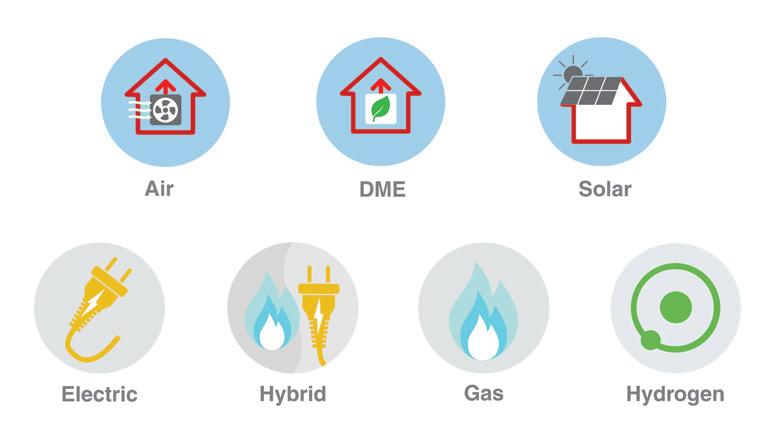
Rinnai is embarking on an ambitious and innovative programme of launching several new products within its H1 – Hydrogen and DME ready water heaters, H2 – Hybrid systems and H3 – LowGWP heat pumps product categories. These new products will ensure the company offers a comprehensive range of appliances and systems for heating and hot water suited to both commercial and residential applications.
The programme will commence with the launch of the new low-GWP air source heat pumps with R290 refrigerant. Following this will be an innovative range of electric cylinders of
multiple sizes and instantaneous electric water heaters ranging from 21-27kw. Also there will be the introduction of the KCM and E Series of condensing gas-fired water heaters for light commercial and residential applications.
Later in the first quarter of the year will see the launch of plate heat exchangers for larger commercial and industrial sites.
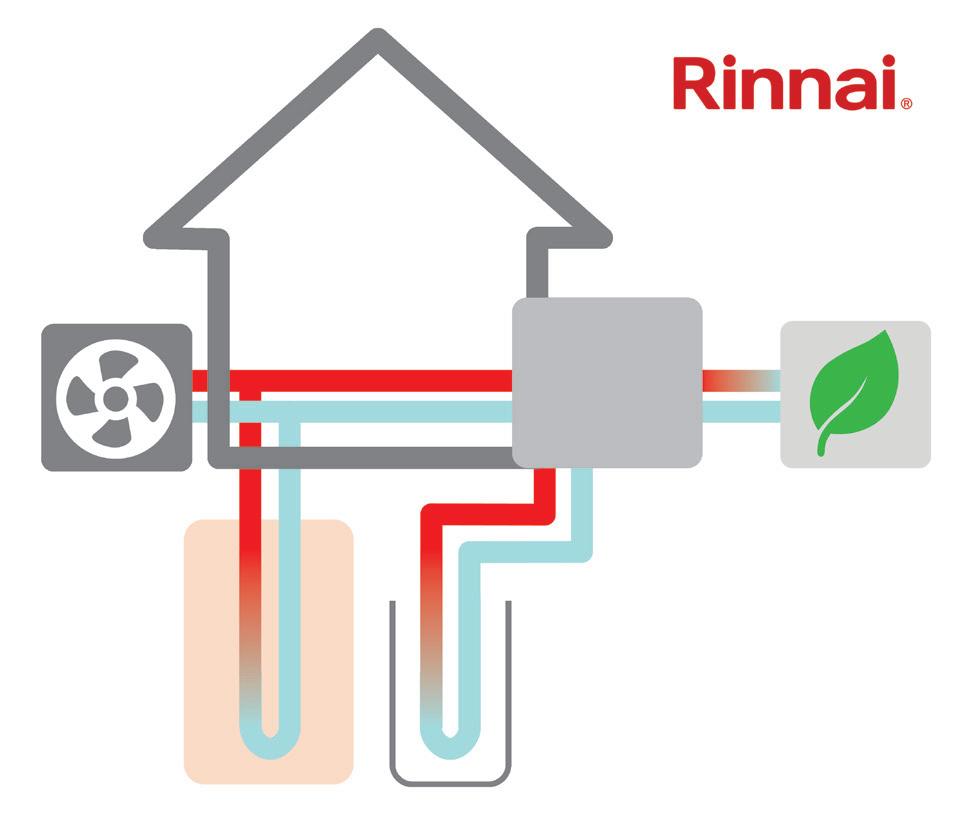
Rinnai is determined to provide UK customers with cost effective low carbon solutions towards commercial hot water
Empowering and enabling the UK to meet ambitious net zero goals
How we’re inspiring local and national climate action.
At Salix we’re passionate about delivering decarbonisation projects across the UK on behalf of the Department for Energy Security and Net Zero, the Department for Education (DfE) and the Scottish and Welsh Governments. Our expert teams work with public sector clients throughout the decarbonisation journey, sharing knowledge and experience. We also run regular webinars and tackle challenges together.
Our schemes include:
› Public Sector Decarbonisation Scheme
› Low Carbon Skills Fund
› Social Housing Decarbonisation Fund
› Home Upgrade Grant
› Scotland’s Public Sector Heat Decarbonisation Fund
salixfinance.co.uk
and building heating provision. For an exclusive pre-launch pack call us on 0300 373 0660 or register your interest at https://www.rinnai-uk. co.uk/contact-us/request-brochure
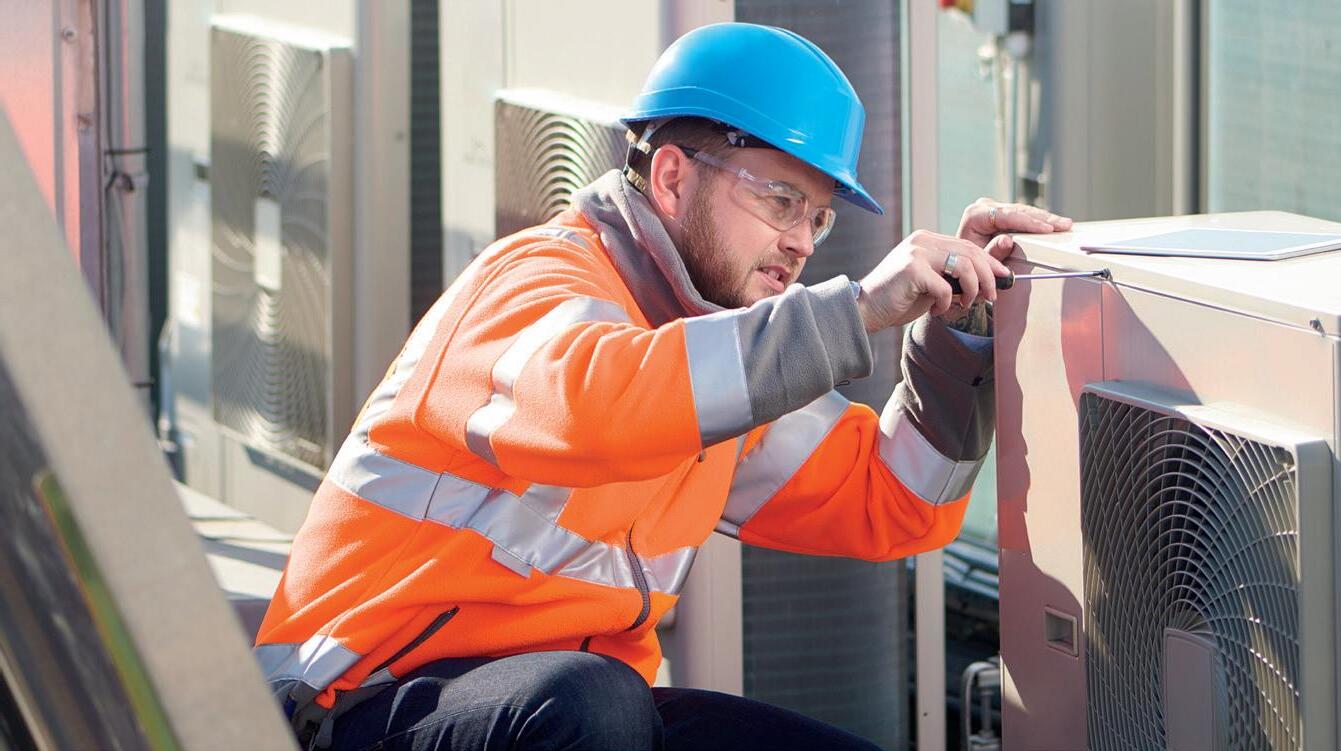
ENERGY MANAGER MAGAZINE • MARCH 2024 NEWS 5 Visit our website to find out more about our projects and our highly skilled workforce

Join the Net Zero Journey with Ideal Heating Commercial’s New Information Hub
Ideal Heating Commercial Products has introduced a new net zero information hub on its website – idealcommercialboilers. com/net-zero – where visitors can regularly return to read up-to-date information on the UK’s drive to decarbonise commercial heating, paving the way to net zero in 2050. It has been created as part of Ideal Heating’s Join the Net Zero Journey strategy, aimed at providing customers with low carbon commercial heating solutions.
The new information hub is home to informative case studies, white papers, and instructive guides created by Ideal Heating.
Case studies, the latest of which include a school, housing development and offices, clearly demonstrate how industry colleagues are deploying low carbon heating solutions to the best effect, and the impact on energy usage and emissions. The full array of Ideal Heating low carbon commercial
heating technologies is covered, from heat pumps through to highly efficient heat networks and hydrogen blend ready boilers.
For more in-depth examinations of low carbon heating and hot water solutions, the White Paper and Guide sections on idealcommercialboilers.com/ net-zero are invaluable. The ‘Heat Pumps – Road to Decarbonisation’ White Paper is essential reading, whilst the new ‘Hydrogen Guide: Understanding the Hydrogen Discussion’ is designed to educate and inform people on the evolving subject of hydrogen in heating. It provides an overview on the use of hydrogen as a fuel for commercial boilers, summarising the key issues and identifying where we currently sit and future possible pathways.

Ideal Heating Commercial’s range of low carbon heating solutions are also addressed on the new Net Zero information hub. These include ECOMOD commercial heat pumps, hydrogen-ready condensing boilers, and POD Heat Interface Units (HIU) for heat networks. idealcommercialboilers.com/net-zero
HEAT NETWORKS IN ENGLAND AND WALES RECEIVE £3.5 MILLION FOR EFFICIENCY IMPROVEMENTS
£3.5 million is being awarded in Round 4 of the Government’s Heat Network Efficiency Scheme (HNES) to 20 local authorities, housing associations, NHS trusts, universities and private sector organisations. The funding aims to improve the performance of heat networks, so they provide better services to their customers, increased efficiency and reduced energy costs.
This latest announcement of £3.5 million will positively impact 25 heat networks across England and Wales, benefiting 5,700 residents, including students, hospital patients, and other private and public sector occupants. This brings the total funding awarded under HNES to over £28 million. Notably, the news comes as the scheme celebrates its one-year anniversary since opening for applications in February 2023.
Furthermore, capital grant funding will result in annual carbon savings of over 422 tCO2e per year over the next 40 years, equivalent to removing the annual emissions of 172 diesel-powered cars, or 6,883 across 40 years. Revenue grant funding will also enable optimisation studies, identifying opportunities for additional carbon savings in the coming years.
Swan Housing, an East London and Essex-based housing association, is among the recipients, being awarded almost £700,000 from HNES for the Bow Cross Estate heat network in Tower Hamlets. The funding will benefit 543 residents, enabling improvements to the network’s efficiency levels. HNES support aims to reduce heat losses, providing greater comfort and improved resilience, particularly for low income, vulnerable residents and those at risk of fuel poverty.
HNES is an integral part of the Government’s broader Heat Network Transformation Programme (HNTP), focusing on developing new heat networks and improving existing ones. This will aim to encourage further investment in the sector and ramp up the UK’s decarbonisation efforts. The scheme provides both capital and revenue funding to optimise inefficient heat networks, enhancing overall performance for the benefit of residents, and ensuring they are futureproofed.
Lord Callanan, Minister for Energy
Efficiency and Green Finance, has welcomed the HNES funding announcement: “Customers living on heat networks need to get the regular, reliable heating and hot water they are entitled to.
This important funding will help upgrade inefficient systems, preventing breakdowns and using less energy, while allowing customers to reduce their energy bills and keep their homes warm.
It’s part of our plan to ensure every home in the country can cut their energy use and save money on their bills.”
Louise Singleton, Principal Consultant at Gemserv, added: “We’re pleased to announce the success of Round 4, with a significant funding allocation of £3.5 million, just as we celebrate the scheme’s one year anniversary.
The diverse range of projects funded in this round is something we are particularly proud of, with the funding set to deliver heightened heat network efficiency for residents in social housing, those within the NHS and students at universities across England and Wales.
Funding delivered under HNES plays a crucial role in supporting the transformation of older heat networks into resilient, low carbon heating solutions, strategically preparing for upcoming sector regulations in 2025.” www.gov.uk/government/publications/ heat-network-efficiency-scheme-hnes
ENERGY MANAGER MAGAZINE • MARCH 2024 NEWS 6
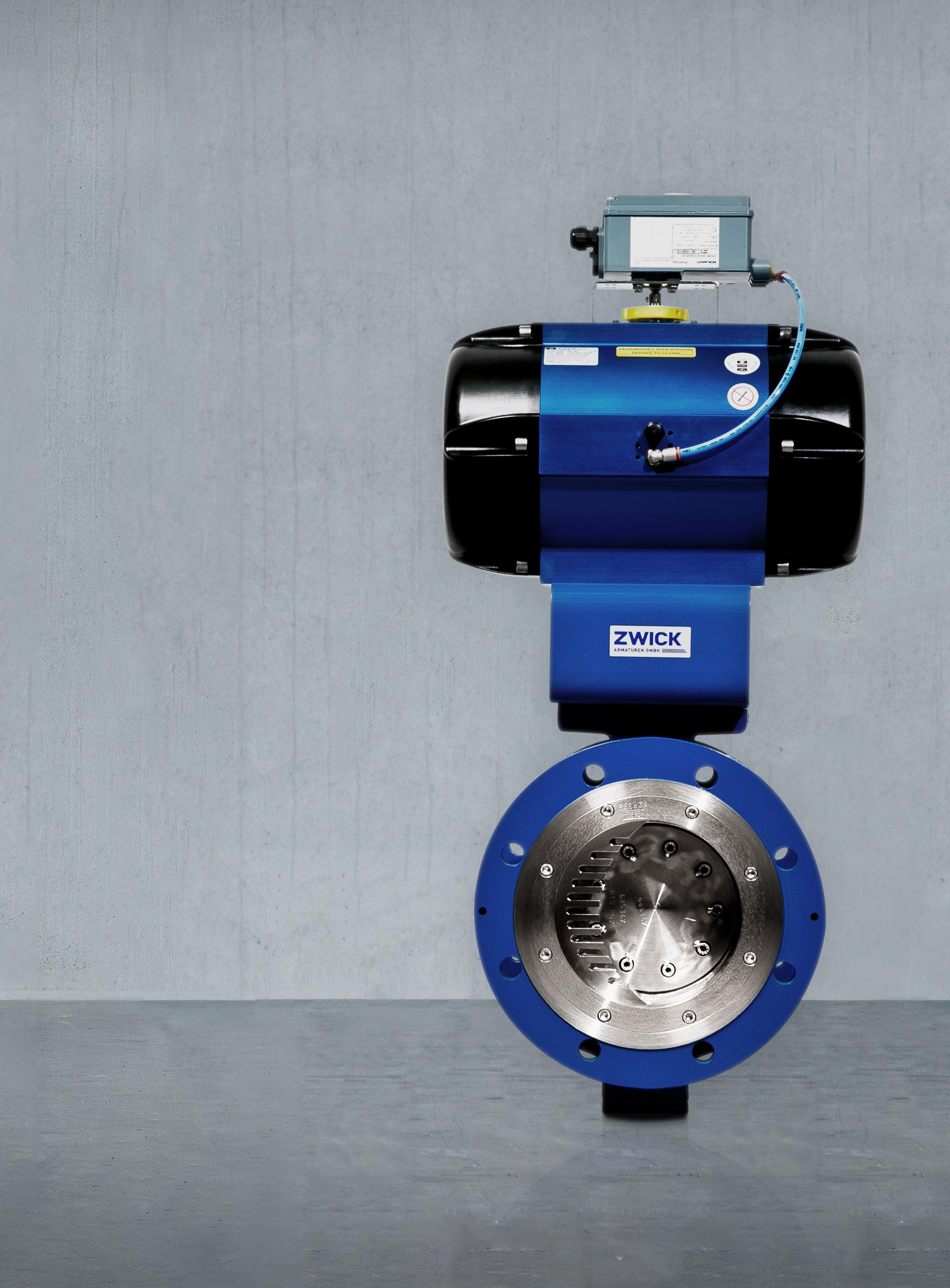
H2-Ready!
WWW.ZWICK-ARMATUREN.DE


THE NEED FOR ENVIRONMENTAL ACCOUNTABILITY THROUGHOUT THE SUPPLY CHAIN
Matt Tormollen, CEO, POWWR
We are in the midst of one of the most consequential energy transitions since records began. The increasing availability of clean electrons has motivated public sector businesses in the UK and beyond to think green. And for good reason. Being environmentally conscious appeases regulators, retains staff, and provides untold goodwill.
The public sector’s move towards a greener future will only continue to gather pace in the years to come. Renewables’ share of the power generation mix is set to rise to over a third by next year alone. With solar and wind driving most of the growth, the renewable energy market is expected to grow from its current $1.21 trillion at a compound annual growth rate (CAGR) of 17.2% between now and 2030.
In their drive to appeal, certain energy suppliers have been guilty in the past of ‘greenwashing’ to exaggerate their environmental credentials. Those suppliers – in addition to those that played fair – have recognised the need for greater environmental accountability. They are, therefore, looking to produce a certificate of authenticity such as a Renewable Energy Certificate (RECs) to prove that the energy they generate is indeed from the renewable sources they say.
A LACK OF CONSISTENCY
Unfortunately, producing a REC or similar is remarkable difficult. Ensuring complete energy genealogy throughout the supply chain is tricky because of a lack of consistent data from top to bottom. This is because the majority of energy production globally still runs
on outdated, bespoke, software that doesn’t play nicely with others.
Also, there is the fact that the systems themselves were designed for predictable assets like coal or oil, not dynamic assets like solar and wind. This dynamism makes the problem of extracting intelligence more difficult as it increases the sheer amount of data being produced. So much so, that the energy industry is now thought to generate up to 200 exabytes of data per year.
Thankfully, there is now technology available – underpinned by the latest in artificial intelligence (AI) and machine learning (ML) – that can sift through this mountain of data in a timely manner. Facilitating accountability by collecting the requisite data to produce the aforementioned REC.
THE NEED TO COLLECT
THE RIGHT DATA
For some time, technology has been used to facilitate everything from providing an endto-end connected journey for energy sales, to managing risk at a time of unprecedented price volatility. Yet, recent advancements in technologies such as Internet of Things (IoT) sensors, robotics, and AI have helped create novel approaches for the energy industry to help public sector organisations meet climate and sustainability goals. However, accessing these devices – and the data held within –can still involve manual and time-consuming processes. Even when technology such as AI can help, it must be remembered that it is only as good as the data the flows into it.
Today, it is not just about collecting more data from such devices, but the right data. So much so, that the market for the use of big data analytics products within the energy sector is expected to
grow from $8.37 billion in 2023 to $14.28 billion by 2028, at a CAGR of 11.28%.
COMPLETING THE CIRCLE
As well as certain energy suppliers looking to clean up their act, there are also countless new entrants wanting to set themselves apart by being seen as the green alternative for the public sector. It is no surprise. Any supplier that can help the public sector access cleaner sources of energy will only grow to become an enduring partner for years to come.
Accountability will be key. Ensuring energy genealogy throughout the supply chain became difficult as its production became increasingly decentralised as well as decarbonised. However, technology such as IoT sensors can facilitate this accountability by collecting energy data from a myriad of distributed devices.
For some time, data has been imperative to help predict weather patterns, production demand, and optimise operation process efficiency within the energy sector. But as stakeholders look to hold energy companies accountable for the claims they are making, proving the energy they are producing is from renewable sources has never been more important. Or more difficult. Yet, using the latest in AI empowered technology can help complete the circle.
The benefits are twofold. As data becomes more prevalent and accessible, energy management solutions will also become more precise, amplifying the benefits public sector organisations can derive from renewable energy. At the same time, it will enable businesses to save on energy costs, whether by procuring energy from the cheapest supplier or facilitating energy use when rates are cheapest. www.powwr.com
8 ENERGY MANAGER MAGAZINE • MARCH 2024 COVER STORY

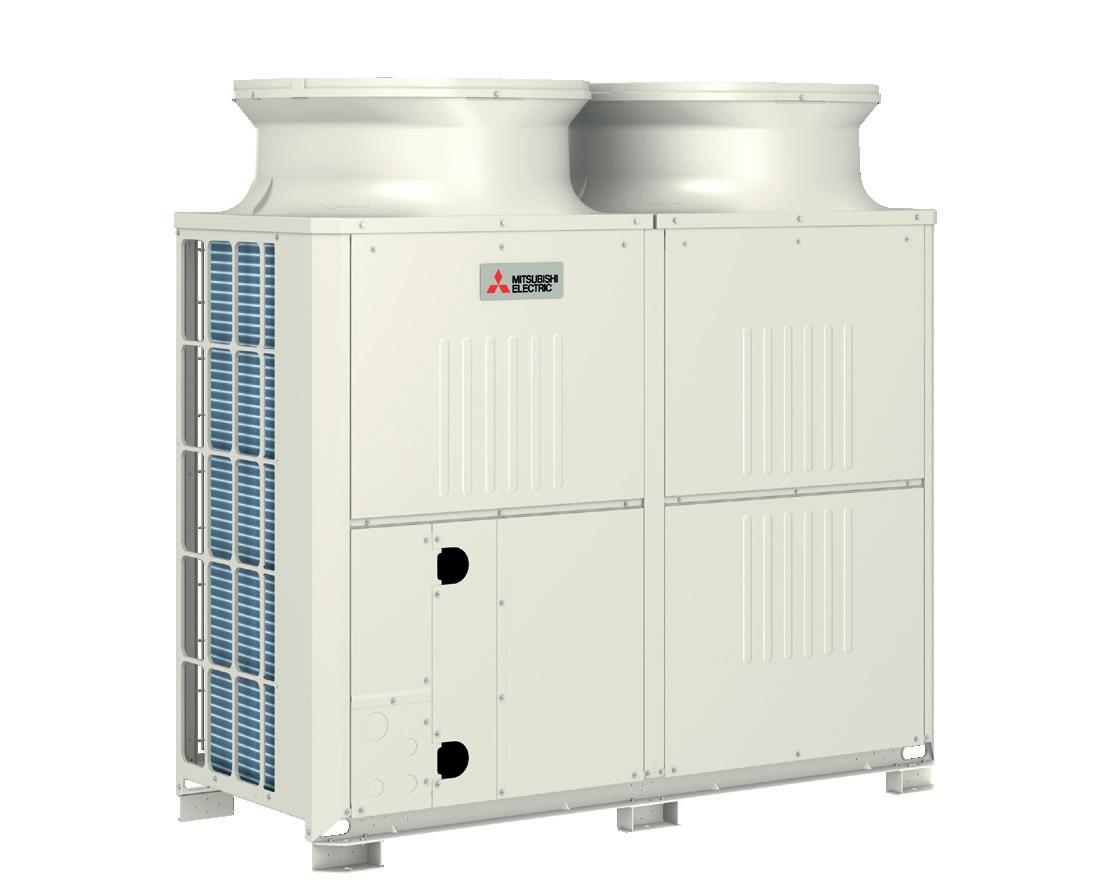

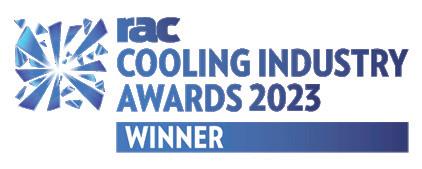


WASTE, TIME, AND MONEY
OFFSETTING AND REDUCTION
With target deadlines set, organisations are well on their way to realising their strategies. The inexorable march of time dictates that 2050 will come around all too soon. While 2030 is as close as 2018, when Britain was subjected to ‘The Beast from the East.’
Carbon neutrality can only be achieved by lowering the emissions an organisation is responsible for, or increasing the amount it removes from the atmosphere. The latter being proactive investment in initiatives, such as:
Carbon Dioxide Removal (CDR) – the planting and management of forests, and Direct Air Capture (DAC) – facilities using giant fans to extract CO2 from the atmosphere. Carbon Sequestration, Negative Emissions Technology (NETs), along with Carbon Capture and Storage (CCS) undoubtably play their part, but are beyond the time and financial resources of many organisations.
So, this leaves most businesses examining ways to reduce consumption.
REDUCTION WITHOUT COMPROMISE
The UK student accommodation sector, with more than 1.7 million student rooms in the UK estate, has a population that is greater than that of our second city. It is a large consumer of energy and its space and water heating accounts for 70% of the energy it uses. But how much of that is essential? And how much is unnecessary? More to the point, how much is wasted? Only specific monitoring and better information can tell us.
Investment in energy control is expected to reduce consumption. But with that there usually comes a compromise in comfort. However, utilising
Adrian Barber, from Prefect Controls, identifies waste as an ‘easy win’, towards net-zero and decarbonisation targets.
existing technology can identify and cut energy use without any compromise.
Renewable energy procurement is a small but obvious step to take in helping net-zero and decarbonisation targets. But focusing on monitoring use, within individual student rooms and bathrooms, and reducing waste without compromising comfort, produces surprising results.
Since 1997, our controls have enabled accommodation providers to manage the time and temperature available to residents. Rooms are kept at a comfortable level, and occupants can boost the temperature, but only for a pre-set time. The controls are always striving to reduce energy input. When rooms are empty or the pre-determined boost-time elapses, input is reduced. A basic concept!
BETTER INFORMATION, BETTER CONTROL
Technology has enabled these rudimentary controls to become very sophisticated. Measuring, monitoring, and managing energy use throughout entire campuses via a secure internet portal. Automatically reducing unnecessary energy consumption, when windows are open, rooms are empty, or the ambient temperature is comfortable. Sensors measure air temperature; electric current; water temperature, volume, and flow. They detect supplementary heaters; over-heating;

leaking pipes; dripping taps; overconsumption; faulty cisterns; defective elements; vacant rooms; even flow of hot water through a tundish.
WASTE IS BENEFITTING NO ONE
Better information and better control are essential in reducing consumption. But the big difference we are experiencing, is that our reductions have no impact on the room occupant. Our systems are controlling essential use and eliminating unnecessary use, while identifying and reducing waste.
SMART Tank has revolutionised data gathering for water systems within our properties. Recently a site was alerted to a leak. By the time the maintenance team reacted, 26,000 litres of water and 1,283kWh of electricity had been wasted. Across another estate, over an 8-month period, 2.3 million litres were wasted.
Real time monitoring provides reliable information and alerts, but the maintenance reaction is what counts! Time spent developing a swift response procedure, to deal expeditiously with notifications, is an investment that will only pay dividends.
The outcome – complete overview of properties, and elimination of waste. An ‘easy win’ in reducing consumption, great for the bottom line, great for net-zero targets, and achieved without affecting student comfort.
www.prefectcontrols.com
10 ENERGY MANAGER MAGAZINE • MARCH 2024
MANAGEMENT
ENERGY
PEL 103





Bridge the energy gap between today and tomorrow. Increase energy e iciency and reduce your costs.

Our future energy needs are changing and businesses need to improve their energy e iciency. You can reduce required power generation, save money and increase productivity.
Gain a competitive advantage now with the PEL 103.
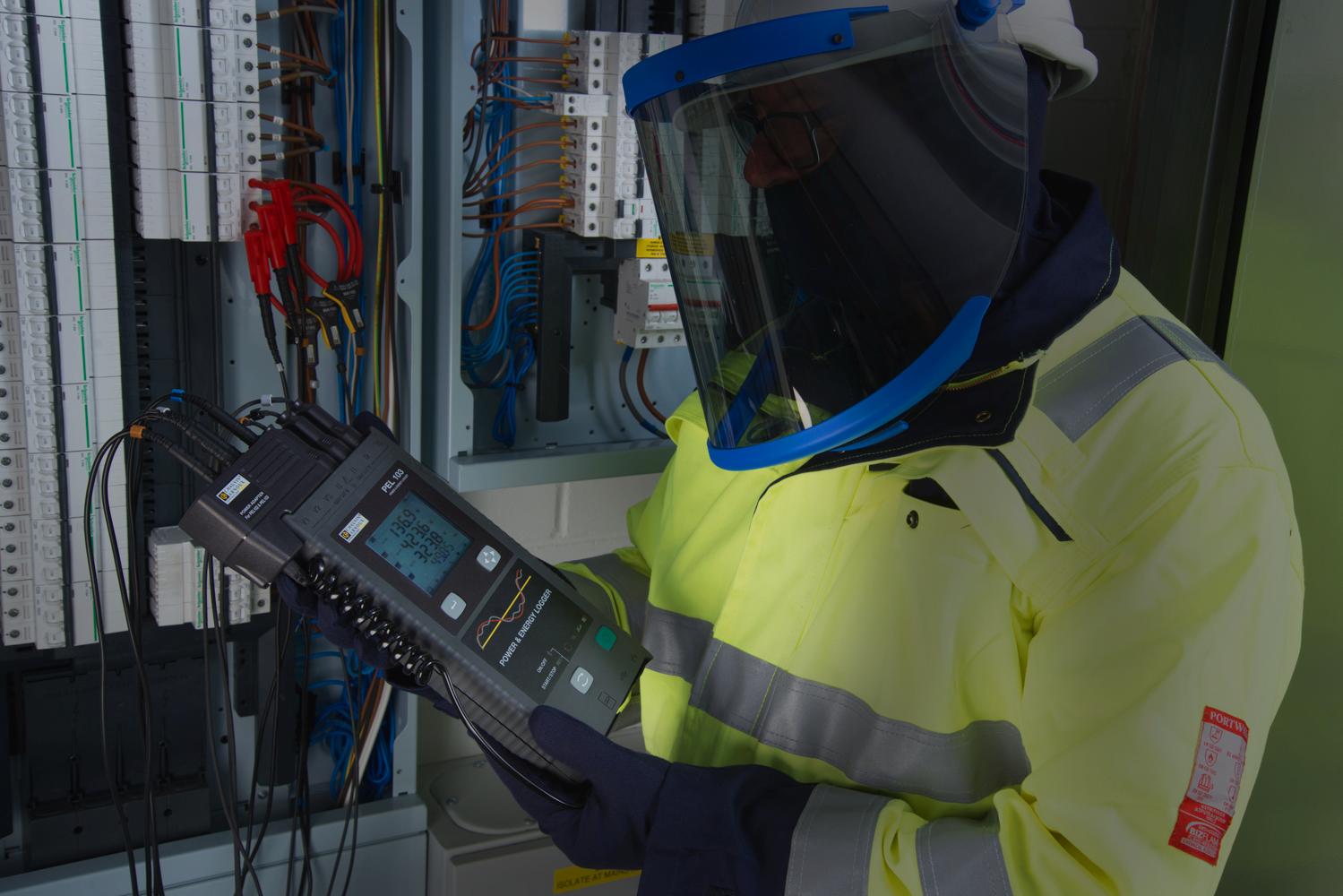

The key to a reduced carbon footprint & improved energy e iciency.
Measure and monitor power usage.
Identify ine iciencies and out of hours use. Discover power factor, phase balance and harmonic issues.

Contact us to learn more
CHAUVIN ARNOUX UK Ltd | 125 YEARS IN BUSINESS | 30 YEARS IN THE UK 1 Flagship Square | Shaw Cross Business Park | Dewsbury WF12 7TH | T: 01924 460494 | E: info@chauvin-arnoux.co.uk
Power & Energy Logger

THE GREEN REVOLUTION: TAMING THE ENERGY BEAST WITH TECHNOLOGIES FOR A SUSTAINABLE FUTURE
Dr James Crosby, Head of Sustainability, and Antoine El Tayah, Sustainability Consultant at Advantage
The energy market and costs to companies over the past few years has been akin to a wild beast – hard to predict and imperative to manage. Companies are discovering that the secret to taming this beast lies through transformative internal reflection. The journey to net zero is no longer just an environmental ideal but a strategic advantage, opening doors to new opportunities and financial savings. As the ripple effect of each company’s environmental impact becomes increasingly scrutinized under the lens of scope 3 emissions, adapting to greener practices is not just advisable: it’s becoming a necessity. With government regulations tightening their grip, the race to identify and implement green technologies and processes is on. This article is your guide to navigating this new landscape, offering a roadmap to significantly reduce emissions and, importantly, cut costs. Here are our top picks for the technologies every energy manager should consider and implement on their path to net zero.
SOLAR PV
Solar PV installations, when appropriate, is the most beneficial technology for businesses in the UK. It is proven, consistent and currently should be a no brainer. The main reason being that generation hours coincide with the common business hours. Depending on the size of the system, you can reduce grid reliance by 15-40% on a system that will pay for itself on average in 4-5 years and has a covered lifespan of 25-30 years.
LED LIGHTING
LED lighting is the best technology for saving money and helping the environment. These lights last much longer than regular bulbs – up to five times longer – with an average life of 50,000 hours. They use very little power, only between 6 and 18 Watts, which is much less than other lights that
Utilities.
can use as much as 500 Watts. They are cheaper to run and use less energy. LED lights have a return on investments of about two years and will keep you saving money for many years after that.
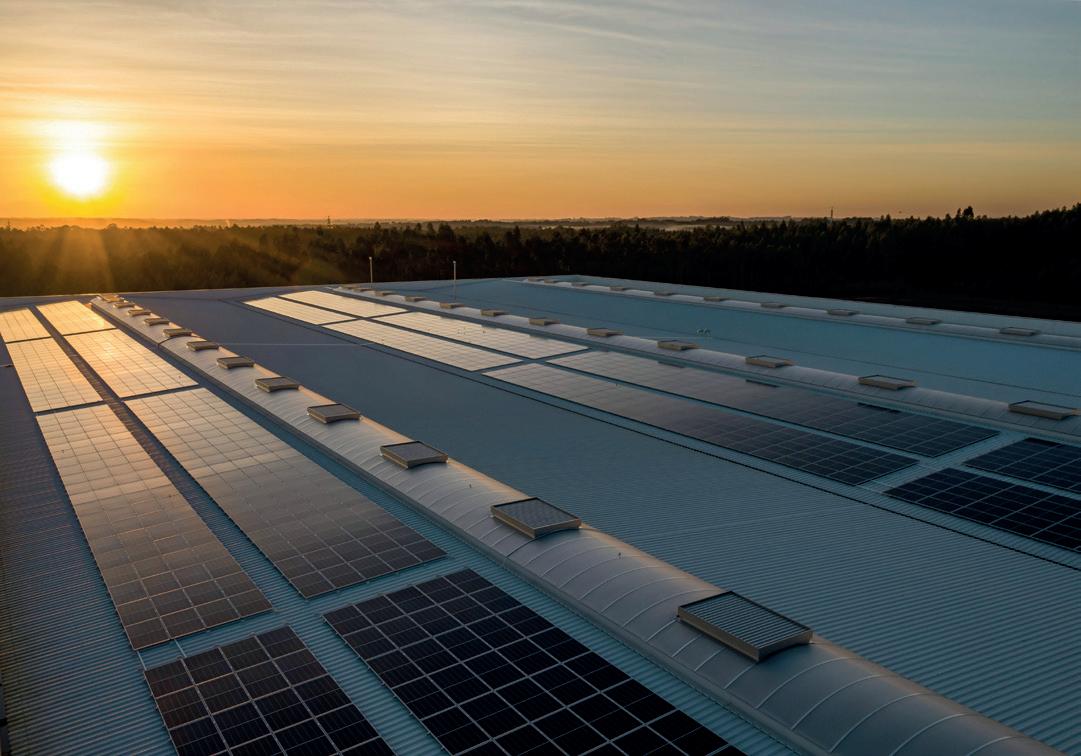
VOLTAGE OPTIMISATION
Voltage Optimisation, or VO, is a method that adjusts the voltage coming from the power grid to better match what your company needs. Essentially, lowering the voltage that comes into your facility means you’re using less power. This leads to reduced energy consumption and therefore fewer emissions are produced. This technology works best with energy uses over 150,000kWh a year, especially if you have equipment that uses a lot of power. VO can help you cut down your electricity bills by 6% to 12% and protects your equipment from damage as incoming voltage is controlled.
HEATING, VENTILATION AND AIR CONDITIONING (HVAC) OPTIMISATION
HVAC systems are often the most underappreciated part of a building. Including a smart optimiser improves how long the systems operate. Even with modern heating systems, the refrigerant compressor keeps running even after the building reaches the desired temperature. A retrofit solution allows the compressor to operate, when necessary, as determined by sensors monitoring the temperature of the air coming in and going out. This approach can lower operating expenses by 10% to 30% and offers a return on investment (ROI) within 1 to 3 years.
EV CHARGERS
Electric Vehicle (EV) chargers are a cornerstone in the shift towards sustainable
transportation, offering a dual benefit of reducing emissions and generating revenue. By providing the infrastructure for electric cars to recharge, these chargers facilitate a decrease in the reliance on fossil fuels, significantly cutting down the carbon footprint associated with vehicular travel. Businesses can attract eco-consciousness and generate income through charging fees. EV chargers thus stand at the intersection of environmental responsibility and economic opportunity, promoting a greener planet while offering a new revenue stream.
The shift towards sustainability is not just a moral imperative but a strategic business decision. The technologies and processes discussed here offer a roadmap for companies looking to reduce their carbon footprint and operational costs. From harnessing solar power and optimizing lighting, to managing voltage and optimizing HVAC systems, each solution presents an opportunity to contribute to a greener planet while saving money. Furthermore, the adoption of EV chargers encapsulates the essence of this transition, bridging environmental stewardship and economic gain. As the world moves closer to net zero, the adoption of these technologies will not only ensure compliance with tightening governmental regulations but also position businesses as leaders in the drive for a sustainable future. In embracing these innovations, you would not only safeguard the environment but also secure your place in a rapidly evolving market landscape.
https://www.advantageutilities.com/
12 ENERGY MANAGEMENT ENERGY MANAGER MAGAZINE • MARCH 2024


PrefectControls.com HOW MUCH ENERGY ARE YOU WASTING? Central control Local control * Savings are dependent on current control methods, infrastructure, location and profiles adopted. By heating empty rooms, or spaces where windows and doors are open, you are wasting up to 40% of your energy budget. Our control systems ensure Energy and Accommodation Managers , responsible for multi-occupancy dwellings, can be confident they are only using energy when it is necessary. CENTRAL CONTROL All ecostat2 features + Secure portal access + Humidity + Light + Sound pressure + CO 2 + Water heating + Leak detection • up to 40% savings * LOCAL CONTROL • Room temperature • Setback, Boost & Frost • User adjustment • Open window • Absense detection • Tamper-proof • Programmable • Electric or wet systems • up to 30% savings * Scan for product comparison

DIGITAL TWIN TECHNOLOGY IS PAVING THE WAY TO NET ZERO
Digital twin technology offers a way of revolutionising our approach to energy efficiency and will be a powerful complementary force alongside developments in the physical technologies driving the energy transition. These digital replicas of physical assets and processes, built on sophisticated mathematical models, go beyond static simulations by incorporating live data and allowing highly complex systems to be evaluated in real-time. The technology allows us accelerate design, predict failure & maintenance, and optimise the performance of energy assets much more effectively than conventional methods allow –digital twins have revealed that there is some low hanging fruit in the form of easily achievable energy efficiency gains, and will play a crucial role in achieving our net zero 2050 targets.
WHAT’S NEXT FOR DIGITAL TWINS IN 2024?
Companies specialising in digital twin technology have attracted over $1.2bn in funding over the past two years, with several companies securing funding rounds above the $10 million mark. Despite growing attention to the technology, the industry remains nascent, with few instances of rounds above $30 million.
With key players continuing to mature & demonstrate the impact of their technology against the backdrop of more favourable market conditions, we expect a more robust fundraising market with larger funding rounds as competitors build market share.
The companies poised to succeed in this market will be those with early commercial traction and seasoned management teams with domain expertise in their target markets. Such expertise is crucial given the complex nature of problems and solutions in play.
ENERGY GENERATION AND STORAGE
Several pioneering companies are harnessing digital twin technology to revolutionise the optimisation of energy assets. The technology can be deployed throughout the entire lifecycle of an asset, enhancing design, predicting

potential failures before they occur, and significantly prolonging asset longevity.
ENERGY TRANSMISSION
Digital twin technology is also being applied to complex issues in energy transmission, tackling key challenges in energy infrastructure from network design to resilience requirements and maintenance challenges.
HARNESSING THE POWER OF DIGITAL TWINS FOR A NET ZERO FUTURE
Advances in artificial intelligence and greater access to data are key enabling factors in the development of digital twin technology, addressing a market that is expected to grow at over 40% per annum to $130 billion by 2030. As these trends continue to play out, we expect to see a substantial increase in the application of digital twin technology in the energy sector. The energy management system market alone (where digital twins are a key enabling technology) is expected to reach $60bn by 2025, driven by rising investments in renewable energy infrastructure and the growing adoption of digitalisation in the energy sector. This growth reflects the significant demand for solutions that enhance operational efficiency, reduce carbon emissions, and support sustainable energy practices.
Digital twin technology has a pivotal role to play in enabling our
Written by Adam Aziz, Analyst at DAI Magister
path to net zero by tackling the core problem, our consumption of energy, at the source. The technology can unlock efficiency gains throughout the value chain from the design of energy assets to the optimisation of energy systems in operation and life extension of critical infrastructure. The core technology is applicable to a wide range of optimisation problems and as a software solution, can easily be deployed across a broad spectrum of project sizes at minimum incremental cost – this enables asset owners and operators of all sizes to enhance the efficiency of their asset base.
Furthermore, the ability of digital twins to simulate various scenarios and predict performance outcomes allows energy companies to make informed decisions that align with sustainability goals. Whether it’s optimising the performance of renewable energy assets, improving grid management, or enhancing energy storage systems, digital twin technology offers valuable tools for driving efficiency and reducing environmental impact.
This dual benefit of reducing environmental and economic burdens will continue to fuel significant market interest in the coming years, with investors keeping a close eye on companies with seasoned management teams, a proven track record of commercial success, and a clear path to scaling profitably.
https://www.daimagister.com/
14 ENERGY MANAGEMENT ENERGY MANAGER MAGAZINE • MARCH 2024

PRESENTING ENERGY MANAGEMENT DATA TO THE C-SUITE
Effective energy management is one of the building blocks of decarbonisation. Therefore, presenting accurate, comprehensive and current energy management data to the C-suite or board of directors has never been more important.
Organisations are under pressure to set and reach their net-zero goals and must showcase how they will meet their targets with a detailed plan. Backing up and championing a net-zero strategy requires meaningful data.
WHY IS PRESENTING ENERGY MANAGEMENT DATA TO C-SUITE DIRECTORS IMPORTANT?
Amidst the UK net-zero deadline, the Paris Climate Agreement, internal pressure from employees and external pressure from rising customer and supply chain expectations, c-suite directors are required to reduce their organisation’s carbon footprint.
Many organisations must also comply with mandatory schemes, such as Streamlined Energy and Carbon Reporting (SECR) and the Energy Savings Opportunity Scheme (ESOS).
Many of these reports and disclosures are based on energy and carbon emissions data and contain recommendations for consumption reduction initiatives and energy efficiency improvements.
Energy efficiency and decarbonisation are company-wide efforts, and no plan can be successful without board-level support.
WHAT MAKES AN EFFECTIVE ENERGY MANAGEMENT STRATEGY?
Energy is one of the main expenditures for businesses to consider, shoulder to shoulder with personnel, premises, and equipment.
Typically, larger organisations have a procurement team that focuses on purchasing energy at the best possible price and developing a risk strategy, while energy managers usually focus on reducing consumption and improve efficiency.
However, many organisations don’t have the in-house resources to manage these, so quite often procuring and managing energy falls to facilities, operations or even finance teams.
A powerful energy management strategy not only covers buying but also reducing energy consumption over
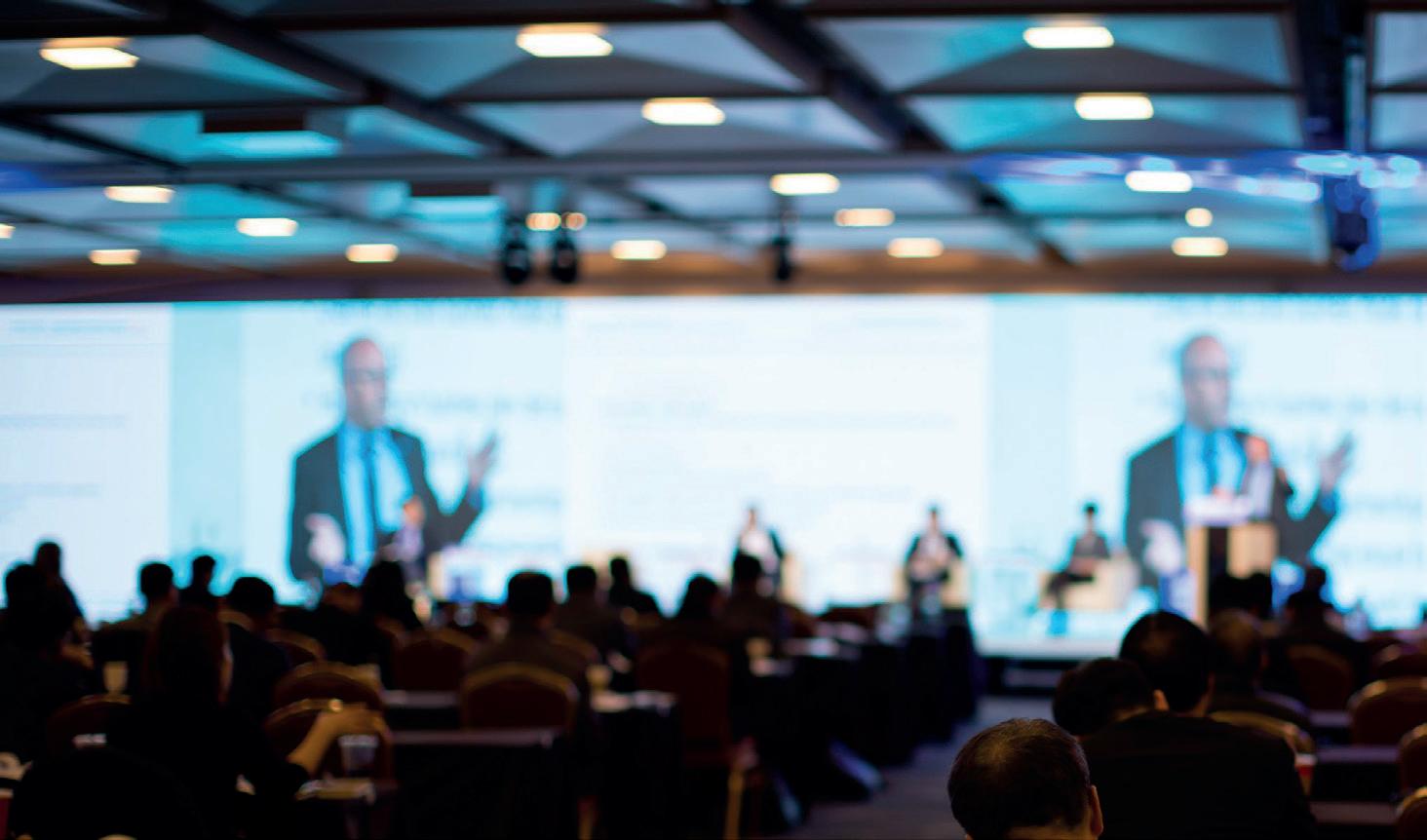
time. This should include reviewing what the organisation does well, cutting out wasteful practices, pinpointing areas for improvement, in-depth data analysis and identifying savings opportunities while tracking progress throughout.
But you can’t manage what you don’t measure. Many organisations can’t effortlessly state their current energy use to then make reductions. This is why access to accurate, up-to date and presentable energy management data is vital.
WHAT DO C-SUITE DIRECTORS NEED TO KNOW?
Directors need to understand and advocate their company’s position and plan to decarbonise their operations and mitigate climate change.
To support this, internal teams must ensure the organisation utilises the most efficient ways to control, monitor and report their energy use.
Methodical energy monitoring and analysis can reveal operating issues that affect performance and quality, as well as uncover efficiency opportunities.
Regardless of whether the performance of individual assets in your organisation’s portfolio is of interest, the C-suite will want collated, comparable data sets converted into clear and engaging representations of a site’s energy profile.
These visuals should support demonstrating the impact of energy efficiency efforts, making investment decisions about consumption reduction projects and new technologies, as well as encouraging and maintaining internal behavioural change.
Once an organisation understands its energy use, cost and carbon targets and the corresponding energy management strategy have a starting point. Setting and communicating targets not only indicates an organisation’s commitment to its supply chain and customers but drives accountability and aligning teams internally.
TOP TIPS FOR ENERGY MANAGERS ON HOW TO PRESENT ENERGY DATA
• Use charts to visually display data – Excel documents can be difficult to interpret and read.
• Dashboards on your energy software can be shared showing comparative data (league tables against multiple sites within a portfolio that can be reviewed monthly / yearly). Include drill-down functionality in your reporting to allow colleagues to interrogate the data further if they wish.
• Present the data alongside the organisation’s targets.
• Show granularity – electricity and gas should be recorded through half-hourly meter data.
• Demonstrate the investment and ROI of major capital items, for example LED lighting and heating and cooling systems.
HOW CAN SYSTEMSLINK HELP?
This article was provided by SystemsLink, the UK’s leading provider of energy management solutions.
https://systems-link.com/energymanagement-software/
15 ENERGY MANAGER MAGAZINE • MARCH 2024 ENERGY MANAGEMENT

WHICH TECHNOLOGY IS BEST AT REDUCING ENERGY COSTS? SOLAR POWER, COGENERATION OR VOLTAGE OPTIMISATION?
Choice overload is the name given to the phenomena where an abundance of choice overwhelms our cognitive ability to make effective decisions. The end result is often no decision at all, or at best a choice that is suboptimal. Businesses making decisions about cutting energy costs may face this dilemma when surveying the options available to them. In this article, Stuart Hawkwood, founder of Powerdown220, compares the pros and cons of three different technologies that can help organisations reduce their energy bills.
There are many technologies out there which have the potential to reduce energy costs. In this situation, it is easier to stick to the more familiar or widely known options, like solar panels, which are now visible on many rooftops, or combined heat and power (CHP), which is backed by government support.
However, don’t let too many choices blind you to the presence of lesser-known alternatives that might deliver more value for money. Voltage optimisation is one technology that can give both solar power and CHP a run for their money and might be able to
provide you with a quicker return on investment (ROI). Here’s a summary of what all three technologies have to offer:
HARNESSING THE POWER OF THE SUN: SOLAR POWER
Solar power is a sustainable and environmentally friendly energy source. It harnesses energy from the sun, which is abundant and inexhaustible, in contrast to fossil fuels. Once installed, solar panels generate electricity and although there are maintenance and replacement costs to be considered, the energy generated is free. This can
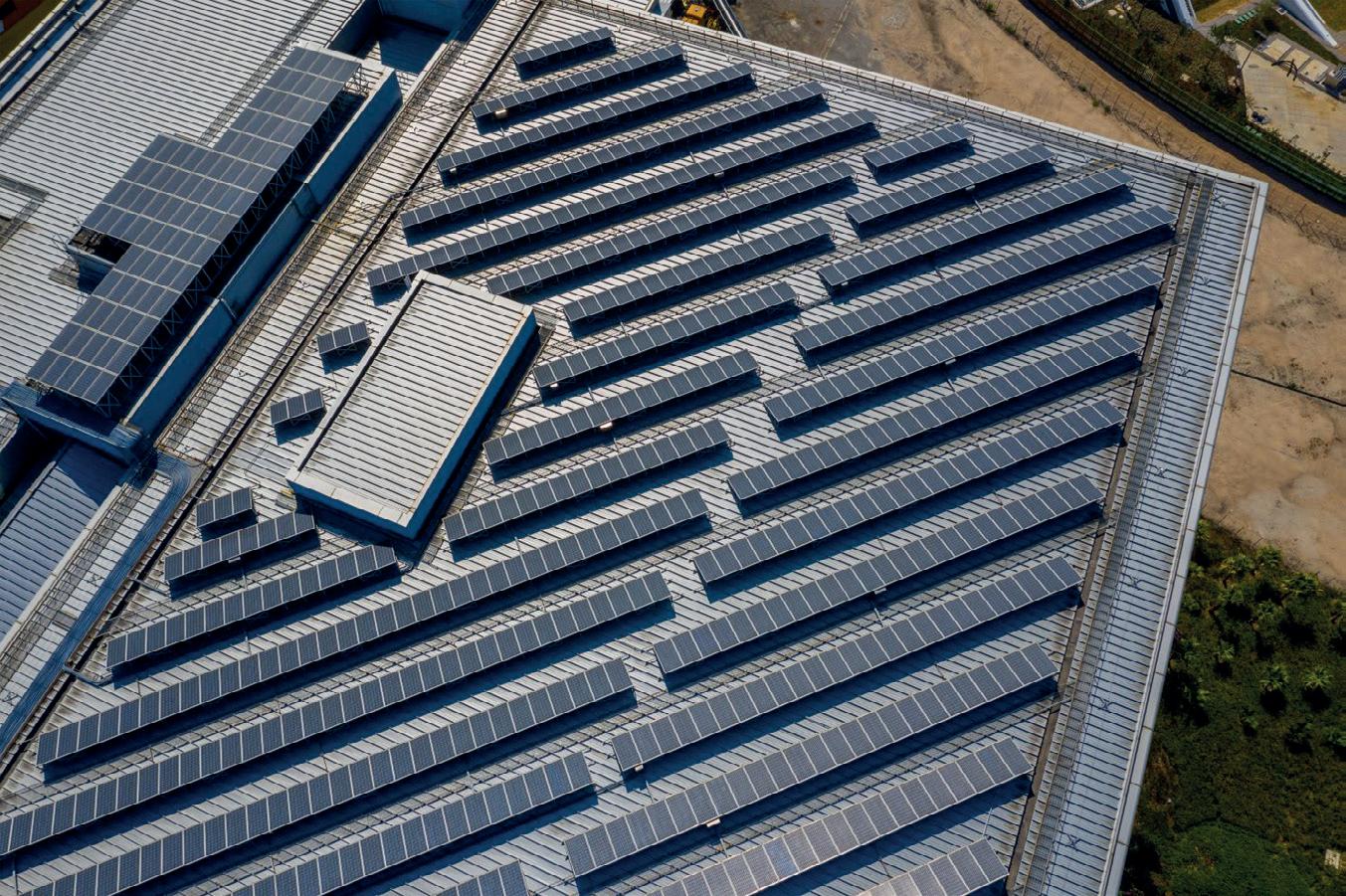
significantly reduce a business’s energy bills and provide long-term cost savings. By reducing or eliminating the need for grid-generated electricity, solar power reduces a business’s carbon footprint, which can be a big selling point for sustainability managers and environmentally conscious consumers.
A major drawback is the high upfront cost of purchasing and installing the solar panels, which can be substantial. This may be a barrier to entry for small and medium-sized enterprises. A significant amount of roof or ground space is also required, which may not be feasible for all businesses.
Another drawback is that as solar panels are reliant on sunlight, energy generation is intermittent. This means that energy production drops during cloudy days and at night, which necessitates energy storage solutions such as batteries, further adding to the costs.
COGENERATION (CHP): EFFICIENCY THROUGH COMBINED HEAT AND POWER
Cogeneration systems simultaneously produce electricity and useful heat from a single fuel source, resulting in greater energy efficiency when compared to separate power generation and heating systems. By capturing and utilising the heat that is a natural byproduct of the
16 ENERGY MANAGEMENT ENERGY MANAGER MAGAZINE • MARCH 2024

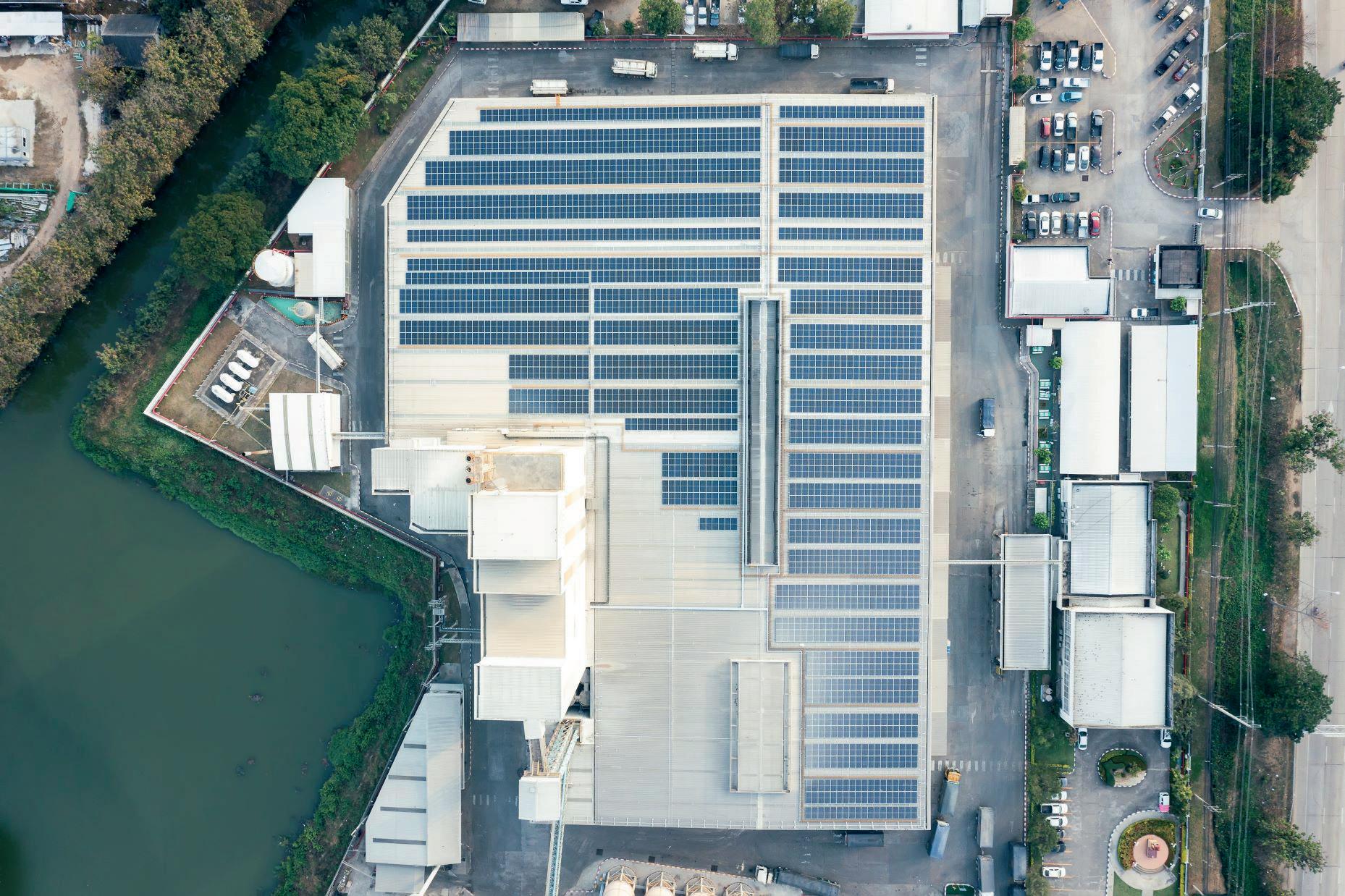
electricity generation process, CHP can reduce carbon emissions by 30 per cent when compared to the separate means of conventional generation via a boiler and a power station.
CHP systems can lead to substantial savings by reducing the amount of energy required from the grid, ultimately reducing energy bills. The reliability of these systems is another advantage, which makes them ideal for businesses with critical power needs like hospitals or data centres.
However, although the government has heavily backed this technology due to these benefits, like all technologies it has some drawbacks and not all businesses can benefit from CHP. The economics and practicality of this technology depend on factors like the facility’s heating and electricity needs, location and access to suitable fuels.
Another factor to consider is the complexity of CHP systems. This means they often require specialised maintenance, which increases the operational cost and the need for skilled personnel. Finally, while CHP systems are efficient, the environmental benefits may be limited if fossil fuels are used as the primary energy source.
VOLTAGE OPTIMISATION: THE BEST KEPT SECRET?
The most surprising thing about voltage optimisation (VO) is that, just
like the science behind it, it is not a new technology. It’s a mature technology that is proven to reduce energy consumption by lowering your supply voltage from the grid to match the requirements of your equipment. This typically results in savings on your energy bills of between seven and twelve per cent, but savings of up to twenty per cent are also possible. In a climate of rising energy bills, it is an effective way of future-proofing your business against increasing costs.
Lowering your voltage to match the requirements of your facility and its equipment also extends the lifespan of that equipment, providing further savings on maintenance.
The compatibility of the equipment is another benefit. Although this article has presented the three technologies as potential rivals, VO is a versatile technology that can be easily integrated into electrical systems, making it suitable for a wide range of businesses and capable of being paired with other technologies like solar power, CHP and other forms of renewable generation.
The key benefit of VO when compared with solar power and CHP is that VO typically offers a rapid return on investment (ROI). With the ROI being between one and three years, it is a very attractive option for cost-conscious businesses. Due to the science of VO, calculating your return on investment is usually a straightforward process
and a good supplier should be willing to provide a savings guarantee after having completed a technical survey.
However, it is worth acknowledging that compared to solar power and CHP, although voltage optimisation does result in significant energy savings, it does not match the energy production capabilities offered by these more celebrated technologies. Furthermore, although reducing energy consumption is positive from a sustainability perspective, it is better for lowering costs and its direct environmental impact is therefore more limited.
While solar power and CHP are undoubtedly valuable energy technologies, VO deserves a closer look for businesses who are keen to cut costs. Although too much choice can be overwhelming, it is certainly worth adding VO to the conversation. The guaranteed savings and rapid ROI could make VO the leading choice for businesses wanting to future-proof themselves in the face of rising energy prices and it can be effectively paired with other technologies like solar power too.
If you want to find out how much your business could save from voltage optimisation, you can fill out Powerdown220’s free calculator and find out in just two minutes by visiting https://powerdown220.co.uk
17 ENERGY MANAGER MAGAZINE • MARCH 2024 ENERGY MANAGEMENT

OPTIMISING EFFICIENCY: CONDITION-BASED MAINTENANCE FOR ENHANCED ASSET MANAGEMENT
There are several challenges facing the FM industry and it is great to see them being addressed, although more needs to be done. The term “We have always done it this way” is slowly fading and it is fueling innovative solutions that attempt to solve key issues such as maintenance inefficiency and operational energy wastage.
One such innovative solution is datadriven maintenance or condition-based maintenance. This approach utilises live asset performance data from various sources across a building which, when analysed, can be used to make more informed maintenance decisions.
EXPLORING TRADITIONAL METHODS FIRST
Before we assess the importance of condition-based maintenance, we must first explore traditional methods. Planned Preventative Maintenance (PPM) adheres to widely recognised industry standards, such as SFG20, to determine how assets should be maintained. SFG20 has served the industry well for many years and works by assigning a series of tasks for each asset type that, when carried out, guarantee’s compliance and reduces the risk of breakdown. Each maintenance task has an estimated time to complete and frequency in which they should be carried out (Weekly, Monthly, Quarterly, Biannual and Annual). The maintenance tasks are then planned throughout the year in a PPM schedule for the engineer to carry out.
TRADITIONAL METHODS VS DATA-DRIVEN APPROACHES
The main issue with traditional maintenance methods is the inability to consider the actual condition of an asset when not on site, resulting in inefficiencies from carrying out noncompliance inspection tasks on an asset that is working well. Furthermore, with the periodic nature of PPM there is an overreliance on being in the right place at the right time and all too
often the first sign of a problem is a breakdown and an emergency call out.
When there were no alternatives to this method it was a perfectly reasonable approach as risks associated with asset downtime can be costly. However, thanks to the advances in technology, there are now readily available, cost-effective solutions that not only creates maintenance efficiencies, but also reduces operational energy wastage.
Accessing asset data is now possible either by tapping into the data that already exists within a building or implementing specialist IoT sensors. Once you have the data, it can be analysed to give users live asset performance analytics that can not only evidence when an asset is working correctly, but also highlight assets that are showing signs of inefficiency and potential breakdown. By concentrating on the problematic assets and not those that are evidently working well, you will create maintenance efficiencies and eliminate most unexpected asset failures. Not only will this save cost, but it will also reduce the workload of stretched engineering teams due to the limited availability of engineering resources.
FIRST TIME FIX
Adopting a condition-based maintenance strategy does not mean that assets will not break down, asset breakdown is inevitable, however, the

callout process and overall management will be more efficient by using data for offsite diagnosis. As the old adage goes, “you can’t manage what you can’t measure” so by looking at the data you can identify likely causes which enables you to assign the right engineer, with the right tools and materials for the first time. This not only reduces the building downtime, but it also reduces the inflated costs associated with call outs.
ANTICIPATING END-OF-LIFE FOR COSTLY PLANT ITEMS
Predicting asset end-of-life can be a minefield and maximising the value of an asset is incredibly challenging. Trying to understand the most cost-effective time to replace an asset is near impossible using current methods. Guides like CIBSE Guide M will give you an estimated lifespan of an asset; however, the guide uses asset usage assumptions in its end-of-life calculation which may not correlate to your assets. By using data, you can take into consideration the actual rate of usage and apply it to existing guidelines to make it more accurate.
https://www.demandlogic.co.uk/

18 ENERGY MANAGEMENT ENERGY MANAGER MAGAZINE • MARCH 2024
by SomeCG from Pixabay
Image

POWERING PROGRESS: THE NEED FOR EV INFRASTRUCTURE IN DRIVING AN ELECTRIC FUTURE
Heidi Thompson, Group Fleet Manager, Mitie
With transport accounting for almost a quarter of the UK’s greenhouse gas emissions, the switch to electric vehicles (EVs) has been a priority for almost every business in recent years. In September 2023, the Society of Motor Manufacturers and Traders (SMMT) reported that 800,000 EVs had been registered in the UK since 2018, with three quarters of these new registrations coming from fleets. At Mitie, we’ve just welcomed our 4,000th EV – a big milestone for one of the UK’s largest zero emissions fleet.
However, like trying to accelerate with the handbrake on, it’s essential that the infrastructure is there to keep up with the demands of growing electric fleets. Whilst organisations do have more breathing room with the UK’s deadline for a complete EV transition pushed back from 2030 to 2035, they need to remain focused on developing an EV strategy that equips them for the future and makes sure that the shift to more sustainable transport isn’t stalled by a lack of vital infrastructure.
PUTTING ON-SITE INFRASTRUCTURE IN THE FAST LANE
Range anxiety is a major issue when it comes to getting, and keeping, more EVs on the road. Whilst most plugin cars are able to cover the average commute (28 minutes according to the Department for Transport) without needing to be charged, the cost of public charging and difficulty finding available chargers remain a significant concern for drivers, particularly those driving longer distances. In fact, the SMMT’s research in 2023 found that two thirds of drivers see a lack of infrastructure as a barrier to going electric.
This means organisations have an important role to play in providing sufficient on-site charging points, not only to encourage more colleagues
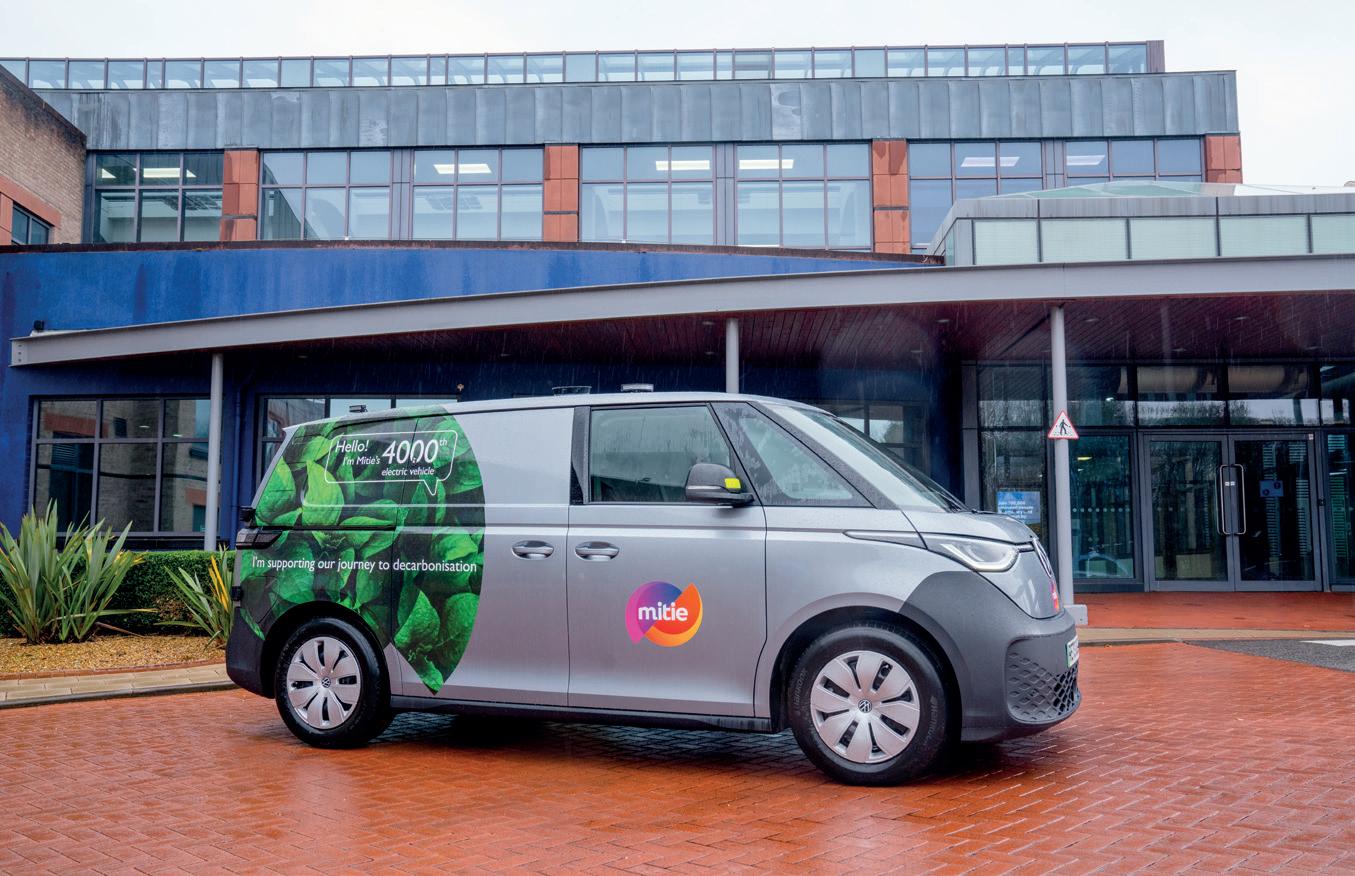
to make the switch to an EV, but also to keep their own fleet in motion. The latest high-voltage chargers are able to charge up a vehicle in less than an hour, so EVs can remain always ready to drive, crucially reducing the need to rely on any petrol or diesel vehicles. Investing in charging infrastructure will future-proof organisations’ estates as the ban on new petrol and diesel vehicle sales, and net zero targets, approach.
GEARING UP FOR MAINTENANCE REQUIREMENTS
Like any other piece of equipment, charging infrastructure requires regular and proactive maintenance to make sure that its always working reliably and efficiently and to keep it running for as many years as possible.
We’re using intelligent software to monitor how charge points are performing in near-real time. The system also alerts Mitie engineers to faults or issues that need repairing so that they can carry out fixes and restarts remotely wherever possible or send out an engineer to the site when necessary. This drives quicker fix times, keeping charge points in service.
PREVENTING GRIDLOCK
In 2022, research by the Competition and Markets Authority found that 60,000
more EV chargers will need to be installed by 2035 if the UK is to achieve a full EV transition. All these charge points depend on reliable grid connections.
With unprecedented demand for approvals for new connections to the grid, microgrids could offer an innovative way for organisations to realise their green transport ambitions, using clean power produced on-site. Microgrids also give the option to deliver power back to the grid when there is surplus and receive power from a central source when it’s needed, relying on AI to assess data on energy generation and balance supply and demand. Whilst the technology is still developing for microgrids to be rolled out at significant scale, by getting ahead, we can encourage organisations to generate clean power on-site whilst also giving them confidence that they can always access power from the grid when they need it.
Whilst it’s positive that number of zero emission vehicles on the roads is rising, there is still work to do in delivering the infrastructure that will accommodate a complete transition to EVs. Investing in this infrastructure, as well as their maintenance, will be pivotal to organisations reaching their decarbonisation goals. The best time to start implementing these measures is now, as preparing for the future today will only make the transition easier.
https://mitie.com/
19 ENERGY MANAGER MAGAZINE • MARCH 2024 EV CHARGING

CONFUSION & CHAOS OF UK ENERGY DIRECTION
Chris Goggin examines the current state of UK domestic energy policy that focuses on the implementation of clean energy dispersal. As the UK phases out fossil fuels for renewable alternatives a considerable amount of work must be completed for the UK to become carbon neutral. Following is a brief overview of the indecision, chaos, and confusion that the UK energy market finds itself in.
UK energy policy is currently convoluted and chaotic with apparent scant insight into the future pathway and direction provided to customers and energy industry professionals alike. At present, the UK relies on fossil fuels for national energy resources with a future aim of transitioning to significant carbon reducing alternatives. These reductions are targets, written into law. The government of the day is expected to observe its own laws.
As the UK moves away from oil and gas, cleaner energies such as solar, wind and lower carbon gases will become more available and commonplace inside the UK energy market. So, what role will these alternative energies play in a future UK domestic energy mix?
Solar, wind, and greener gasses like hydrogen or renewal DME are likely to play significant roles in delivering power to UK housing and building stock once natural gas usage is nullified. For this to happen, a concise strategy must deliver infrastructure and installations capable of transporting clean energy into UK properties.
To begin, UK decarbonisation plans and commitments have been diluted, preferring instead to expand and increase North Sea oil and gas

production. The Times newspaper recently published an article that quoted the UK’s largest insurance provider, Aviva, as saying: “the government increasingly focuses on short-term energy security over long-term sustainability.”
As European and American big business have embraced large renewable projects, UK political indecision and rising global energy costs has led to a lack of investment within large scale UK renewable projects. Also published in the same Times article as above, Aviva believe that “the recent dilution in government net zero targets is an even bigger challenge and creates uncertainty.”
The Energy Transition Readiness Index 2023 is a measurement of a regions ability to transition towards NetZero. A report is compiled for potential investors to evaluate a country’s viability towards profiteering from renewable electricity. The latest report believes that investors will only be attracted towards UK projects if they can observe clear and succinct governance as well as regulatory stability. Presently there is not enough evidence of either to entice outside capital investment.
Installers, specifiers and consultants of heating & hot water products must absorb centralised information to devise a strategy capable of producing carbonising solutions. Presently, the flow of governmental information can be contradicting and even bipartisan. For a UK national energy transition to be successfully implemented the information and agendas must be clear and consistent.
Without this required synchronicity all those in the supply chain risk appearing uninformed, especially in view of constant misinformation from a variety of questioning sources and bodies. The industry needs a unified approach which delivers clean,
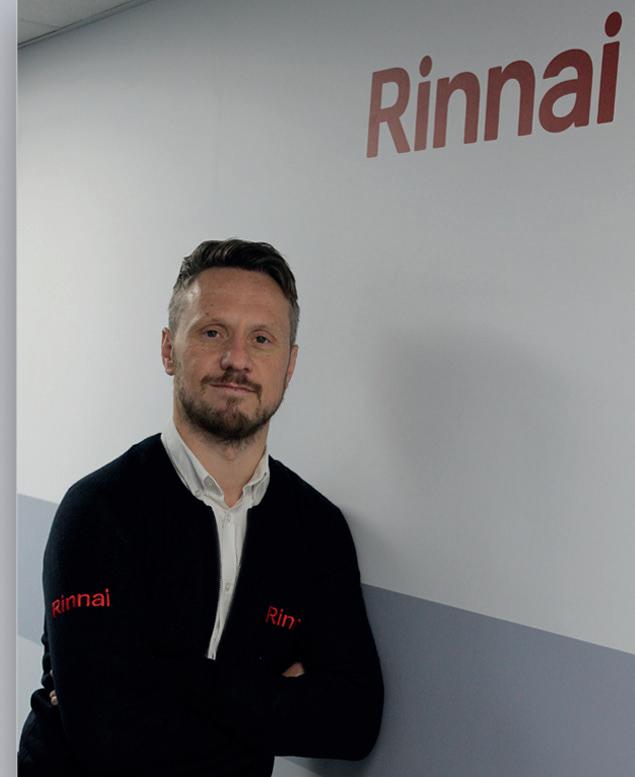
sustainable and renewable energies with all associated appliances and systems.
Hydrogen is an example of the confusion that travels throughout the UK energy sector. Two recent reports have been released claiming a contradicting outcome regarding the future of the UK national gas transmission network. The Future of Great Britain’s Gas Networks Report by the National Infrastructure Commission and Ofgem, say that the national gas network should be decommissioned in favour of widespread electrification.
An additional report funded by UK gas operator Cadent and conducted by The Imperial College of London has stated that a switch to hydrogen as domestic and commercial fuel could save the British taxpayer up to £5 billion a year when compared to widespread electrification.
One of the UK’s biggest names in energy is preparing for a future with hydrogen – this is the UK’s main supplier of property heat and believes a switch to hydrogen is probable. Its website informs all readers of a likely time frame in which hydrogen will be introduced. If the UK does switch to hydrogen the current gas infrastructure will be retrofitted to transport hydrogen gas mixes and eventually 100% pure hydrogen.
Offshore wind is a further area of the energy industry that is encountering problems. Despite government subsidies being made available major renewable firms are beginning to question the viability of huge UK offshore wind projects.
Furthermore, it was widely reported in September that the CFD (Contracts for Difference) scheme failed to attract any bids whatsoever. Although the CFD scheme offered subsidies to
20 OPINION ENERGY MANAGER MAGAZINE • MARCH 2024

foreign investors, European, American, and Asian alternative investment opportunities are currently more attractive.
At the time of writing The Guardian published a story stating that the UK Govt is aiming to raise subsidies by two-thirds and the starting price by 50% to attract financial investment in the next round of offshore wind auctions
Major energy companies that specialise in offshore wind have now either raised financial concerns or have pulled out of planned large UK projects. Danish multinational energy organization Orsted has publicly voiced doubts on the financial viability of their Hornsea 3 wind project off the coast of Yorkshire. A final decision on proceeding to a third stage of project advancement is pending.
Swedish wind company Vattenfall have stopped work on a huge wind farm being constructed off the coast of Norfolk. Both Orsted and Vanttenfall have cited rising inflationary international market costs and inadequate government subsidies as influencing factors in each respective decision.
Solar energy appears to be the least turbulent and contested area of energy adoption. Solar is well placed to play a significant role in future UK power provision. If wider electrification is embraced solar will contribute by way of delivering a source of generational power.
However, due to the uncertain state of UK energy policy any move towards solar will be in the future. The main issue regarding present solar power is a long wait for grid connectivity. Some businesses and domestic customers have been told that they must wait between 10 and 15 years for access to the UK grid. A lack of infrastructure and a queuing system for grid applications are contributing factors in this long wait.
UK energy policy is far behind other economies such as Germany, France, and the Netherlands, let alone Europe as a block and the USA. The UK energy industry lacks infrastructure, financial subsidies or firm decision-making direction and therefore cannot uphold certain decarbonising ambitions as a result. When all the above elements are combined, the UK falls short in offering decent international investment opportunities.
Contractors, specifiers, system designers and installers of home heating and hot water systems should consider companies who offer a range of decarbonising products that ensure low customer costs and efficient performance. Rinnai’s H3 range covers all low carbon needs such as solar, hydrogen and heat pump technologies.
Rinnai believe in providing consistent and transparent updates on domestic and global energy issues that could affect UK decarbonising product options and costs. Rinnai aim to supply UK customers with information that assists investment making decisions on future clean energy heating and hot water systems.
To keep up to speed with the changing face of UK energy policy visit www.rinnaiuk.com and sign up for our monthly newsletter.



21 OPINION ENERGY MANAGER MAGAZINE • MARCH 2024
THE ONLY PUBLIC SECTOR ENERGY JOURNAL www.energymanagermagazine.co.uk Register now to receive your digital issue of Energy Manager Magazine FREE of charge energymanagermagazine.co.uk/ subscribe Image © East Street Imagery

WATER MANAGEMENT
RECOMMENDATIONS ANNOUNCED THAT WILL IMPROVE UK’S WATER FUTURE
Over the last few years, more and more people have become aware there is a global water crisis, and the UK needs to do more to protect its water health for future generations.
According to the World Wildlife Fund, 1.1 billion people around the world do not have access to water. Even more frighteningly, 2.7 billion struggle to find water for at least one month a year.
It is not just a problem for developing countries though, and an increasing number of Brits are worried about the quality of water in the UK, as a result of pollutants and water waste due to poor water leak repairs.
BRITS WORRIED ABOUT WATER QUALITY
A recent poll from the Chartered Institution of Water and Environmental Management (CIWEM) revealed 81 per cent of people are worried about the UK’s nature.
It also found that 65 per cent believe the next government should investigate and possibly reform water regulations in the UK. An additional 11 per cent think this should be a priority for the new government after the next general election.
These concerns are justified given that a House of Commons Committee report revealed that all rivers in England had chemical contamination. It also stated that only 14 per cent met ‘good’ ecological status.
This is despite the Water Framework Directive legal requirement for all rivers to reach ‘good’ status by 2027. Currently, it is not on track to meet this, and the water quality of English rivers remains the worst in Europe.
As CIWEM director of policy Alastair Chisholm and project lead for A Fresh Water Future said: “The public get it. They understand how important water is. In their homes, in their local environments. But they see pollution all around them and big corporates and government saying one thing and then acting like water is an afterthought.”
WHAT ARE THE SOURCES OF POLLUTION?
The main reason for the low quality of river water is agricultural pollution. This impacts 40 per cent of waterways, as chemicals used in agriculture in rural areas run off into the rivers.
This is followed by sewage and wastewater, which affects more than a third (36 per cent) of rivers, including both public pollution and commercial rubbish.
Urban diffuse pollution, which is the run-off from towns, cities and transport, impacts 18 per cent of English rivers.
WATER EXPERTS DISSATISFIED OVER REGULATIONS
At the same time as the public having grievances about how poorly pollution is monitored and managed in the UK, water experts are also dissatisfied over water companies’ operations and actions.
According to CIWEM’s report, only six per cent wanted the current ownership, corporate governance and regulation systems to continue.
While they want great changes when it comes to agricultural and urban pollution issues, as well as drought problems, and water company management, there is no obvious alternative solution.
They simply argue that these challenges, which will result in a further decline in water health, will continue to worsen over the years.
A FRESH WATER FUTURE’S RECOMMENDATIONS
To resolve the grievances of both the public and water experts, A Fresh Water Future has made ten recommendations based on the thousands of views they have garnered.
Before these can be implemented, however, it states an independent review of water policy and regulation needs to be conducted as soon as the next government is in power.
This report needs to be published within its first year of term, so the recommendations can be carried out before the following election.
These suggestions include:
• Water assurance taskforce – A Fresh Water Project believes a ‘water assurance task force’ needs to be established. This ensures there will be more transparency when it comes to reporting, legal compliance from water companies, and governance. Regulators will be given more power to do more monitoring and subsequent enforcement, putting an end to self-monitoring of wastewater and sewerage operations.
• Environmentally-friendly support for farming – As agricultural waste causes so much pollution in waterways across the UK, it is important that something is done to encourage more environmentally-friendly farming. The report found that many people would pay more for produce if this meant an improvement of farm regulations, and a subsequent reduction of pollution. These would include better soil management and more strategic planning, both of which will help rural

Britain cope with floods and droughts, which cause debris to run into rivers.
As the National Geographic explains, floodwater easily becomes contaminated with pollutants, washing pesticides, chemicals and sewage into waterways. This can affect their water quality.
• National nutrient management programme – The group wants to establish a national programme that monitors and manages nutrients, as this would enable a targeted approach on certain areas that are prone to pollution and help to tackle those activities that are causing the most damage to the water quality. There will also be an improvement of planning policies and environmental permitting for livestock production. This will help to prevent more ecological disasters, particularly as these policies will be enforceable. It also wants to create a circular economy when it comes to managing manures from intensive units.
Although these suggestions will make a difference, they have all been made before, with Mr Chisholm stating: “The sad irony in this work is, there’s nothing fresh here.”
He added: “All of it has been said many times before by water managers and campaigners. But most of it has been paid lip service, ignored or delayed, perceived and presented as a cost-burden to growth not a fundamental underpinning of it.”
Over this time, there have been growing pressures on water as the population has increased, while climate change has meant droughts and floods are more likely. Therefore, the need for change is greater than it has ever been.
Despite this, Mr Chisholm is positive for the future, stating: “What’s changed is how clear the consensus is, from a big and diverse sample, that this neglect can’t go on.”
These changes could be transformational to the UK, improving the quality and availability of freshwater all over the country, as opposed to continuing to watch them decline. www.h2obuildingservices.co.uk
22
ENERGY MANAGER MAGAZINE • MARCH 2024
WE CAN REDUCE YOUR WATER COSTS
GOT A HUNCH THAT YOU ARE PAYING TOO MUCH FOR YOUR WATER SUPPLY?
Frustrated by the lack of clarity over how your water service charges break down? Keen to learn whether you might be due a refund for incorrect billing?
YOU HAVE COME TO THE RIGHT PLACE
H2O Building Services is the UK’s leading water cost reduction specialist. Since 1997, we have saved commercial customers millions of pounds in excess water supply and waste water charges, working with some of the most high profile companies in the country1.
With more than 30 years’ experience in water engineering and consultancy services, our professional team has the expertise to help you reduce your water usage and costs significantly.
From site surveys and bill validation through to project management and finance, our mission2 is to help you reduce your water footprint and save you money from a critical business overhead.
PROFESSIONAL WATER CONSULTANTS
H2O offers a full end-to-end consultation service3 on commercial water usage and cost reduction. We are recognised experts in:
• Water audits4: No matter if you run one site or many, we can give you full visibility as to where and how your business uses water, including auditing your waste water and property drainage charges.
• Water bill validation5: Once we have the full picture of how your business uses water, we will check your billing history to make sure you have been charged correctly, arranging refunds if you have been overcharged.
Water cost reduction reports: Our specialist consultants are experts at identifying where you can save money on your water bills, as well as highlighting how you can reduce your environmental impact by cutting water use6
Share:


ON-SITE SOLUTIONS
If you want to put our recommendations into practice, we can help change and upgrade your on-site water systems, from arranging project finance to installation. Our services7 include:
• Water leak detection
Water leak repairs
• Online flow monitoring – smart metering, or automated meter reading (AMR), a web-based water monitoring system.
Water recycling systems, effluent treatment and disposal.
Alternative water supplies – abstraction of water from boreholes and rivers.
Supply and installation of water-saving devices such as water-saving showers, taps, and urinal flush controls.
HOW WE CAN HELP YOUR BUSINESS
Our expert water consultants can help to:
Lower your water bill
Secure refunds for water supply and waste water overcharging
• Provide visibility for how your business uses water
Make billing less complex
• Reduce water waste
Boost your green credentials
Watch the Video here!
1. www.h2obuildingservices.co.uk/case-studies/
2. www.h2obuildingservices.co.uk/about-us/
3. www.h2obuildingservices.co.uk/our-services/water-consultants/
4. www.h2obuildingservices.co.uk/our-services/water-audits/
5. www.h2obuildingservices.co.uk/our-services/bill-validation/
6. www.h2obuildingservices.co.uk/our-services/saving-water/ 7. www.h2obuildingservices.co.uk/our-services/
8. www.h2obuildingservices.co.uk/client-references/
9. www.h2obuildingservices.co.uk/case-studies/
Why not read some of our client testimonials8 and case studies9 to see real-life examples of how we have helped customers save money and improve water efficiency, and what they have to say about the services we provide.






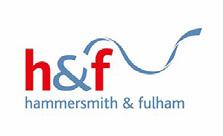
Savings
THE WATER AUDIT EXPERTS
Savings of £500,000 Savings
£750,000 Savings of £850,000 Savings of £200,000 Savings of £250,000 Savings of £950,000 Savings of £900,000 Savings of £250,000
of
expert water consultants today on 0845 658 0948
Call our
at info@h2obuildingservices.co.uk.
alternatively, you can email us
Find alternative water supply and waste water solutions. of £500,000 Savings of £100,000

IN A WORLD WHERE WATER SCARCITY IS INTENSIFYING, THE UK’S UNIVERSITIES HAVE A CRUCIAL ROLE
Neil Pendle, Managing Director, Waterscan
Universities, as major water consumers, have a substantial responsibility to minimise water usage and embrace sustainable practices. Their position at the forefront of environmental scholarship and innovation should necessitate that their own infrastructure is operated in ways that align with the research they produce. Higher education is also a sector in which the UK has a leading global reputation and represents a key part of the national economy. In this context, there are opportunities for these prestigious institutions to show environmental leadership and further enhance their standing.
FOUR COMMON CHALLENGES IN UNIVERSITY WATER CONSERVATION
University campuses hold immense potential for implementing water-saving measures that can yield substantial benefits, including reduced water bills, minimized environmental impact, and a smaller carbon footprint. Yet, despite the scope for sizeable consumption reduction, universities face unique challenges in this area:
• Complex infrastructure: University campuses are often composed of numerous buildings, facilities, and infrastructure systems, making water usage management complex. Aging plumbing systems, multiple water sources, and decentralized decision-making can hinder coordinated water-saving efforts.
• Varied water needs: Water consumption patterns vary across different university departments and facilities. Science labs, medical facilities, and sports complexes typically have higher water demands due to specific activities and equipment. Student housing and dining facilities have very different consumption profiles, but still contribute considerably to overall water usage, as showers, laundry, and kitchen operations in these areas require substantial volumes of water.
• Funding constraints: Water conservation initiatives often require upfront investments in infrastructure upgrades, retrofits, and technology installations. Budget limitations can hinder the implementation of more extensive water management systems. Challenging stakeholders: Students are often vocal and passionate about their concerns. Sustainability and the environment are important topics to them and despite the current challenges of the economy, most don’t want to see environmental targets comprised for savings.

Improving water usage can be a significant task for any industry, but for higher education in particular, these unique challenges are often dealt with by a small team with competing priorities. As a result, water can often end up as lower priority as individuals tackle more ‘public’ issues such as savings, carbon emissions and waste. But reviewing water can actually lead to improvements in all these areas.
DEVELOP A WATER MANAGEMENT STRATEGY
To reap these rewards, universities can develop and execute comprehensive strategies – outlining goals, targets, and action plans – and achieve sustainable water management.
FIVE IDEAS FOR EFFECTIVE
WATER MANAGEMENT
Conduct water audits: Identify departments and facilities with the highest water consumption through detailed water audits and data analysis, which can be beneficial for informing strategic targets and detecting leaks. Combining clear data with onsite knowledge can ensure that the actions taken are right for your university, as every organisation is different.
• Target water-saving measures: Having a clear idea of consumption, helps with prioritising watersaving measures in areas with the most significant impact on overall consumption. For example: waterefficient fixtures – such as low-flow faucets, showerheads, and waterefficient toilets – reduce water usage in bathrooms and kitchens.
Explore water storage and recycling: Consider greywater recycling systems, which reuse wastewater from sinks, showers, and washing machines for toilet flushing and irrigation – reducing reliance on freshwater. Attenuation not only helps to reduce flooding, but also reduces peak demand and the need for treatment.
• Embrace technology: Utilise smart leak detection systems and water monitoring tools to identify and address leaks promptly. This will prevent unnecessary water loss and enhance the approach to ideas one and two. Install smart irrigation systems that adjust watering schedules based on real-time weather data and soil moisture conditions. This will minimise water wasted on landscaped areas and sports fields, and recycle the stored water mentioned in idea three.
• Encourage behavioural changes: Promote water-saving practices among students, faculty, and staff through educational campaigns, awareness programs, and incentives.
CONCLUSION
As high-profile institutions whose students go on to play important roles in all manner of industries and professions around the world, universities can make a vital contribution to addressing the global water crisis and promoting sustainability. By implementing effective water conservation strategies, universities can not only reduce their environmental impact and lower their operational costs, but also serve as role models for sustainable practices in their local communities and beyond.
www.waterscan.com
24 WATER MANAGEMENT ENERGY MANAGER MAGAZINE • MARCH 2024

RINNAI ADDS R290 HEAT PUMP RANGE TO DECARBONISING PRODUCT LIST
R290 High Temperature Air Source Heat Pumps added to Rinnai’s product options. The start of 2024 will see Rinnai introduce further decarbonising options across all appliances and energy formats.
Rinnai has added an additional line of commercial heat pump technology to an already extensive list of decarbonising appliances. The innovative new range of air source heat pumps utilizes R290, a LOW scoring GWP (Global Warming Potential) refrigerant.

units arrive with control systems that allows time sensitive programming and customization enabling specific customer requirements to be met.
R290 allows for several operational benefits: energy efficiency is improved by 10%, the enabling of water temperature up to 75 degrees Celsius and R290 usage provides compliance alongside the European F-Gas Regulation which focuses on phasing down refrigerant environmental impact.
Rinnai is continuing to add further low carbon options for UK customers that require low cost, efficient and durable products. Throughout the beginning of 2024 Rinnai will introduce a comprehensive range of systems and appliances that utilize separate energies for domestic, commercial and off-grid properties.
Rinnai’s R290 air source heat pump range is available in 11 different sizes, from 6 kW up to 50 kW. All
To preview this exciting new range visit: www.rinnai-co.uk/ contact-us/request-brouchure
Rinnai’s air source heat pump range is ratified with an ERP rating of A +++ and A ++ depending on size and can also fulfil UK customer decarbonising ambitions. As well as providing an extensive list of low carbon technologies Rinnai also offer a range of online customer services that assist in customer choice and information.
Rinnai’s carbon calculation service considers design from a holistic perspective of capital expenditure, operational expenditure, and carbon savings. Rinnai’s carbon calculation service will compare a customer’s current heating system to Rinnai’s product list of low carbon, high performance,
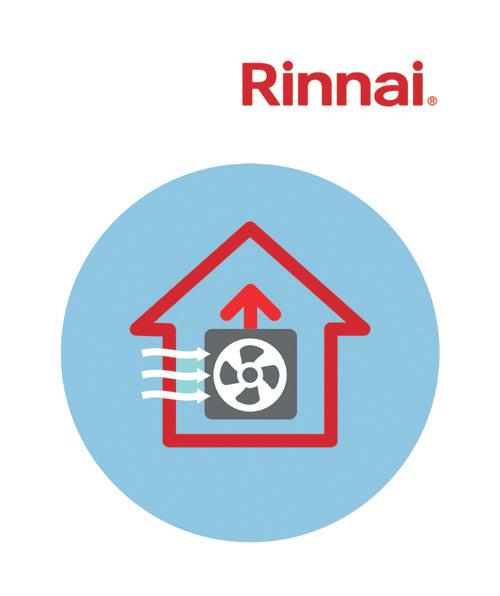
heating systems that are all proven to reduce cost. This feature will enable customers to view proven benefits when investing in a Rinnai system.
Rinnai low-GWP range of heat pumps demonstrate Rinnai’s continuous dedication to producing low cost, highly efficient and thoroughly robust appliances that reduces operational expenditure and carbon emissions.
HEAT PUMPS 25 ENERGY MANAGER MAGAZINE • MARCH 2024

THE DELTA DIFFERENCE

When designing hybrid heat pump systems, optimising the operational design conditions of both technologies and the hydronic design
is essential to
maximise heat pump contribution and system efficiency, says Ryan Kirkwood, Engineering Solutions Manager at Baxi.
As energy managers increasingly focus on reducing the carbonintensity of the heat source in their buildings, low carbon heat pumps are one of the favoured solutions.
A fully served air source heat pump (ASHP) building will deliver one of the lowest carbon footprints in new build properties. Where an all-electric approach is not feasible, integrating ASHPs and high efficiency condensing boilers in a hybrid system can provide a more practicable solution to overcoming project restrictions while meeting heat demand more sustainability. When using mid-temperature heat pumps, our focus here, the challenge is to design both technologies into a harmonious design that successfully optimises individual and overall system efficiency.
OVERCOMING CHALLENGES
The first design consideration must be to maximise heat pump contribution within the project parameters.
Ensuring hydronic integration with peak or back up heat generation that does not penalise system performance or efficiency is also critical. However, this can present challenges due to the temperature differential of the two technologies. Temperature differential, also known as Delta T or ∆T, is the difference between the flow and return temperatures, or the temperature the heat pump or boiler puts out and the temperature which returns to it from the heating system.
Mid-temperature heat pumps typically work best at low flow temperatures and at a temperature differential of 5-10°C. Condensing boilers also operate more efficiently at lower temperatures but at a typical ∆T range of 10-40°C.
So what options are available to
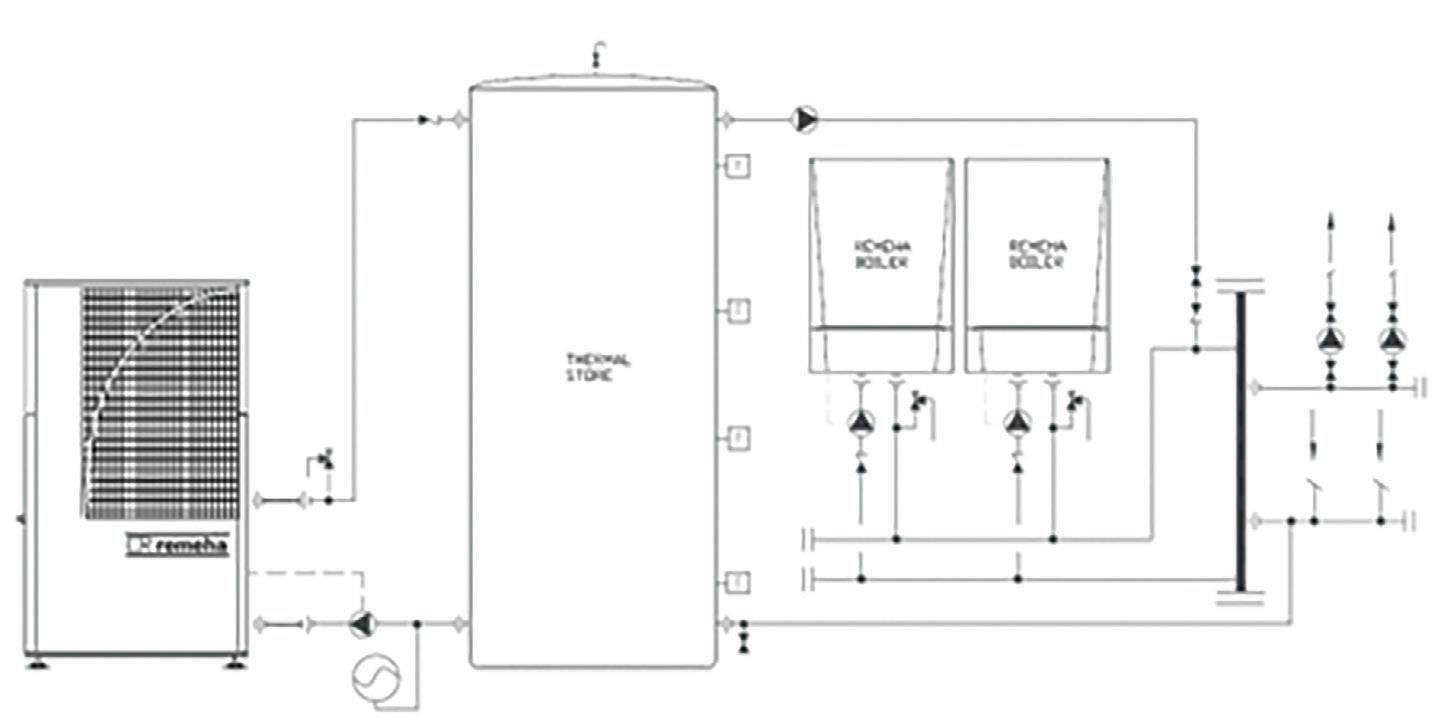
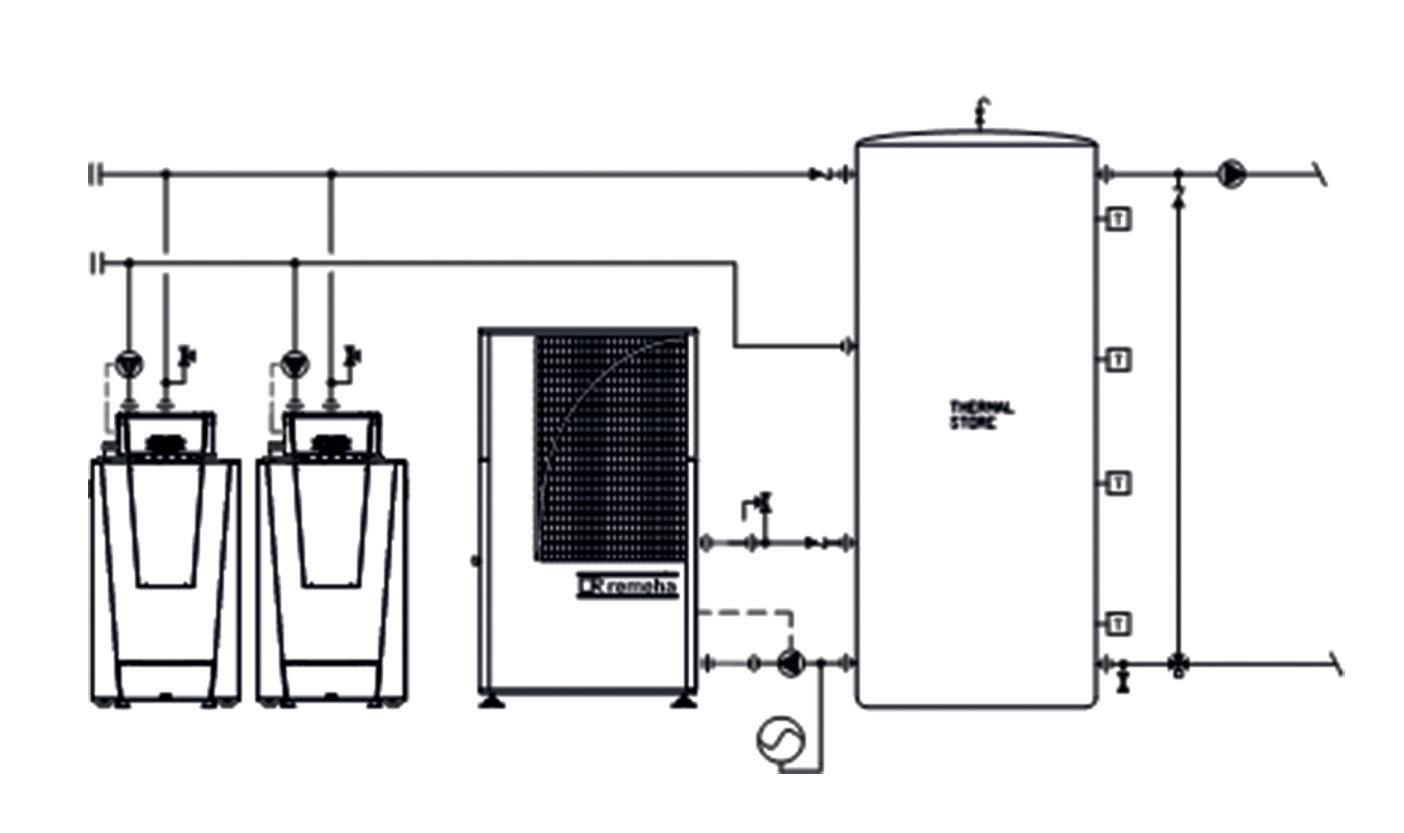
balance efficiency and technologies for optimal system performance?
OPTION 1: LOAD ASSIST
Traditionally, a low carbon heat source runs lead in a baseload configuration with gas boiler(s) to assist as heat demand increases. While ASHP hybrid systems can also be configured this way, the primary flow temperature and subsequent temperature differentials must be suitable for both the ASHP and boiler technology.
Running a full system on a 10°C ∆T (leaving aside pipe and pump
sizes) would not be problematic for most condensing boilers, but it can reduce the performance of some ASHPs which optimise at 5-7°C ∆T. To maximise boiler efficiency and promote condensing, the return temperature must be kept under 54°C.
One example of how this can be achieved is shown in Figure 1.
Two major advantages of this method are flexibility and scalability as both generators can run together or independently as demands fluctuate.
The ASHP charges the thermal store which then discharges, acting as lead boiler. The thermal store discharge
HEAT PUMPS 26 ENERGY MANAGER MAGAZINE • MARCH 2024
Figure 1
Figure 2

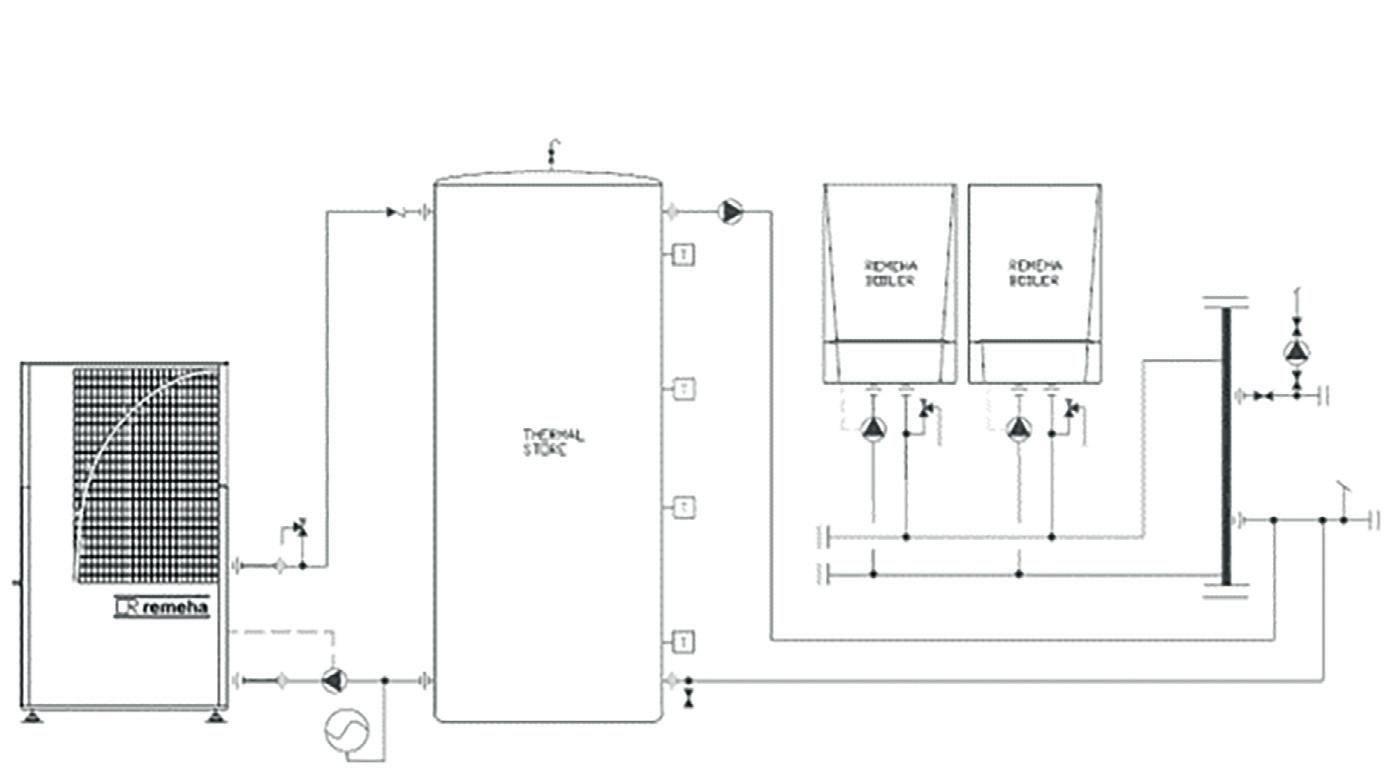
pump can ramp up and down to match building load, avoiding full depletion as this would break the stratification layer and potentially give a lower flow temperature than set point.
Installing heat meters will provide valuable performance metrics to optimise the system and deliver live feedback to the BMS to help control the demand response.
The condensing boilers are cascaded on to duty assist with the demand.
OPTION 2: HIGH DELTA T LOAD ASSIST
In this next approach, the ASHP and boiler operate together in a system where the temperature differential or set point is above that which the ASHP can provide alone. A number of different methods can achieve this.
Thermal Store – As shown in Figure 2, the boiler and ASHP feed into the same
thermal store with the energy required to satisfy system loads spilt. The ASHP maintains a stratified warm layer at the bottom of the tank to heat the cold return with the boiler’s hot layer providing the final lift to reach target flow temperature.
The controls should ensure that the boiler contribution is held back until absolutely required to avoid a temperature overshoot in the tank. Close monitoring of the tank temperatures at multiple points and of boiler and ASHP temperatures will help resolve this.
Injection method – Similar to the thermal store approach, this method uses the gas boiler to boost the flow temperature to set point at times when the ASHP is unable to satisfy the demand differential.
There are many variations on this method. Figure 3 illustrates an example of the injection method working on the return header prior to a low loss header.

The thermal store discharge pump controls the charge and discharge cycle of the thermal store. Under low load conditions, the store may be charged to system temperatures to give usable heat for a finite period without requiring the boilers to cascade on.
During periods of high demand, the thermal store injection will preheat the return for top up by the boilers. Ensuring proper discharge/ charge cycling of the store is critical to the performance of this method.
PRE-HEAT EFFICIENCY LOSS, NETT EFFICIENCY GAIN
We lose approximately 1-2.5% overall efficiency in a gas boiler when preheating a 30°C return by 5-10% due to slightly reduced condensing efficiency. This modest loss is massively countered by the renewable element of the ASHP efficiency. Provided the ASHP is not pre-heating the boiler return above condensing temperatures, the slight loss is acceptable to achieve a nett gain.
AVOIDING CONFLICT
In summary, along with standalone, purposed designed ASHP systems, hybrid solutions offer energy managers an opportunity for important efficiency gains and emission reduction. But to ensure optimal system efficiency and outcomes, careful consideration from the outset of flow and return temperatures, Delta Ts, controls and the detailed hydronic design will be crucial when blending the two technologies. https://www.baxi.co.uk/
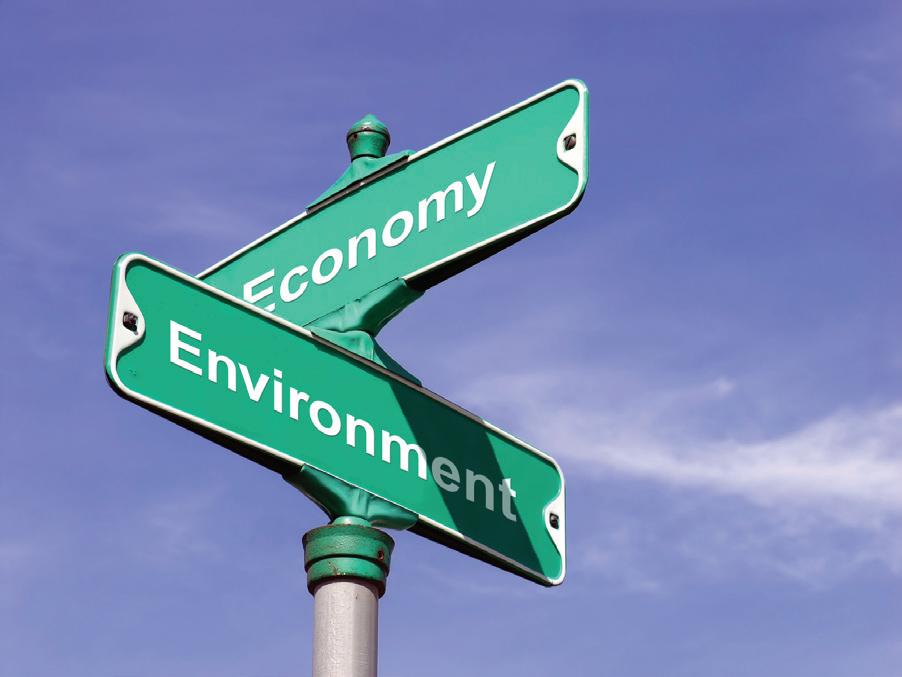
27 ENERGY MANAGER MAGAZINE • MARCH 2024
HEAT PUMPS
Figure 3 THE ONLY PUBLIC SECTOR ENERGY JOURNAL Register now to continue receiving your digital issue of Energy Manager Magazine FREE of charge energymanagermagazine.co.uk/ subscribe www.energymanagermagazine.co.uk

RINNAI HYBRID HEAT PUMP SYSTEM IMPROVES EFFICIENCY AT LARGE HOTEL & GOLF COURSE RESORT
Rinnai UK’s team of Heating & Hot Water System Designers have provided a well-recognized hotel, spa and golf resort in the north of England with plans to install one of two new systems that are proven to reduce cost, carbon emissions and improve energy efficiency.
As well as adding 31 executive rooms the 200-bedroom hotel, spa and golf resort will exchange their two traditional storage tank hot water systems for a Rinnai 20% Hydrogen blend ready continuous flow gas fired water heaters and Hybrid air source heat pump system. The hybrid hot water system contains a 10% heat pump prefeed making the best practical use of the existing space and fuel infrastructure. By completing all refurbishments, the hotel, spa and golf resort hope to increase their rating from 4 to 5 stars.
Rinnai design support is on hand to model and design Hybrid heating and hot water systems, for support with your next project call 0300 373 0660 or visit https://www.rinnai-uk.co.uk/contactus/help-me-choose-product today.
UK commercial and domestic properties are adopting carbon reducing energies in replacement of fossil fuels as part of an international shift that embraces renewably generated energy. By installing a Rinnai hybrid heating system, carbon savings of 267,000 kg over five years can be made when compared to a H1 gas system.
Energy efficiency is a key aspect of system operational performance that affects cost and system durability. The Rinnai UK design team have measured the savings in energy usage that a Rinnai hybrid heating system will achieve when compared to a gas system. Energy savings of 38.5% will be made upon installation of a Rinnai hybrid hot water system utilising state of the art continuous flow water heaters and LOW-GWP
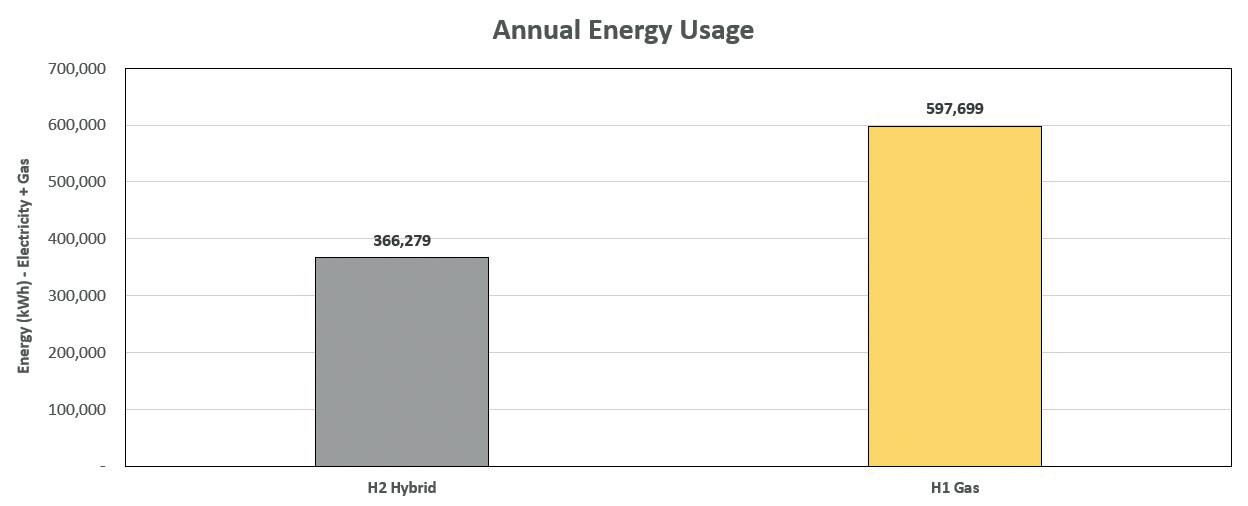
heat pumps. The graph below demonstrates proven energy savings upon investment.
Rinnai’s hybrid heat pump range is designed to satisfy domestic and commercial hot water and heating requirements. The company’s innovative heat pump systems include an ability to switch between settings of heating, hot water and cooling. Recently an R290 heat pump model was added to the expanding range. This innovative new range of air source heat pumps utilizes R290, a LOW scoring GWP (Global Warming Potential) refrigerant.

All new models are designed to embolden decarbonisation, energy efficiency and reduce customer costs.
R290 allows for several operational benefits: for example, the energy efficient units enable a water temperature up to 75 degrees Celsius and R290 usage provides compliance alongside the European F-Gas Regulation which fo-cuses on phasing down refrigerant environmental impact, as well as having a LOW-GWP of 3.
Rinnai’s range of commercial air source heat pumps omit minimum acoustics via an installed ultra-low sound capability making Rinnai heat pumps suitable for any area with prohibitive sound legislation. Rinnai’s heat pumps, hybrid solar thermal and heat pumps and electrical instant and direct water heaters are part of the H3 range of products.
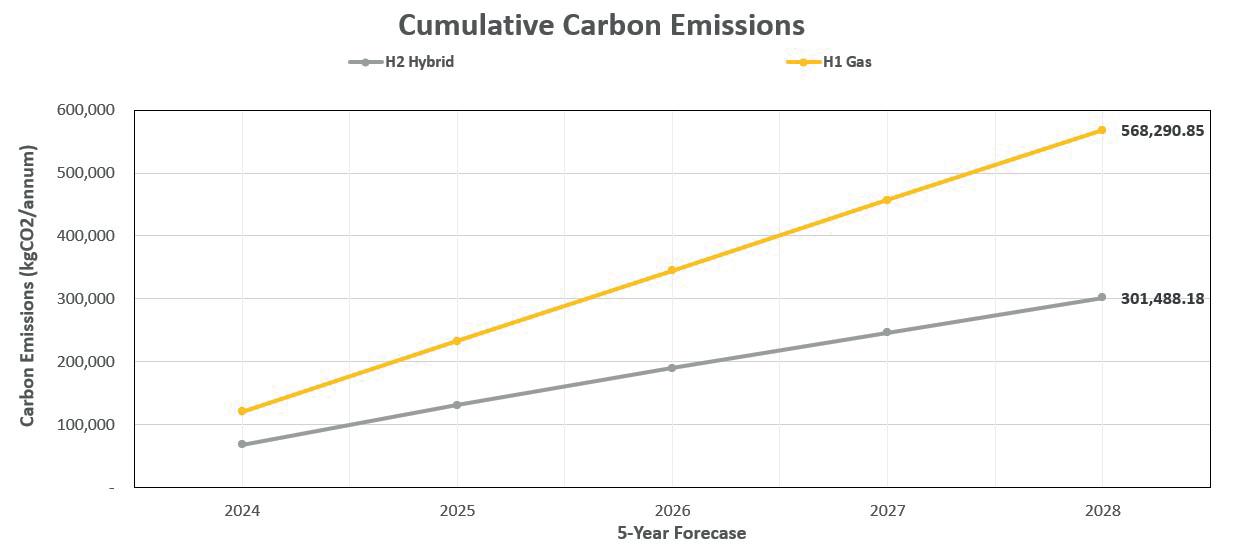
Continuous flow hot water heating from Rinnai includes two N1600 models: the N1600i (internally mounted) provides 954 litres per hour of temperature controlled hot water at 50 degrees.; the N1600e (externally mounted) is also capable delivering 954 litres per hour at 50 degrees. The two 1600s have load profiles of XXL and are water efficiency class A rated. The condensing gas fired water heaters have a 13:1 turndown ratio making them ideal for Hybrid water heating as they will modulate the gas input to suit the temperature lift required which in turn maximises renewable system gains.
Other features include: flue up to 30+ metres for concentric, turbo fan, built-in controller as standard on both internal and external models, cascade cable assembly allows up to 24 water heaters to be connected and function as one total and complete system, built in flue damper, air inlet filter, frost protection – minus 15°C on the internal versions and minus 20 °C on the external versions, new PCB design, controller as standard – lockable, set up of appliance, temperature set up to 75°C and maintenance monitor for engineers.
Rinnai UK’s design team can measure the specific requirements of any residential or commercial property and suggest an appropriate heating and hot water system that compliments the specific dimensions of each site. Rinnai is continuing to produce innovative technology that provides low carbon solutions to all UK customers across a range of applications. Call 0300 373 0660 or visit https://www.rinnai-uk.co.uk/ contact-us/help-me-choose-product
PUMPS 28 ENERGY MANAGER MAGAZINE • MARCH 2024
HEAT

NATIONAL CHAIN OF GYMS INSTALLS RINNAI AIR SOURCE HEAT PUMPS
One of the UK’s biggest chain of gyms and leisure centres has switched to using products from the Rinnai range of commercial air source heat pumps – and electric cylinders – as a major part of hybrid heating and hot water systems at sites up and down the country. The innovative new range of air source heat pumps utilize R290, a LOW scoring GWP (Global Warming Potential) refrigerant.
Ease of install was cited as a major reason for the switch away from one of the major heat pump brands.
The installation team was quoted as stating that ‘Setting up was straightforward and simplified, this was owing to the easy navigation through parameters that enabled their part of commissioning to be shortened. When commissioning other brands there were numerous parameters and set points, in fact there are layers and layers of them – this means that if one is set incorrectly then it can lead to extensive, expensive time on site in rectifying a small issue’.
He added, as the Rinnai systems are provided complete with heat pump, controls, cylinders, valves and auxiliary heat sources along with schematics and telephone support the installation was hugely streamlined.
Rinnai’s R290 air source heat pump range is available in 11 different sizes, from 6 kW up to 50 kW. All units arrive with control systems that allows real time programming and customization enabling specific customer requirements to be met.
R290 allows for several operational benefits: energy efficiency is improved by 10%, hot water temperatures of up to 75 degrees Celsius can be achieved and R290 usage provides compliance alongside the European F-Gas Regulation which focuses on phasing down refrigerant environmental impact.
To preview this exciting new range visit and receive an information pack for all new Rinnai products visit https:// www.rinnai-uk.co.uk/contact-us/ request-brochure and leave your details.
As well as providing an extensive list of low carbon technologies Rinnai also offers a range of online customer services that assist in customer choice and information.
Rinnai’s carbon calculation service
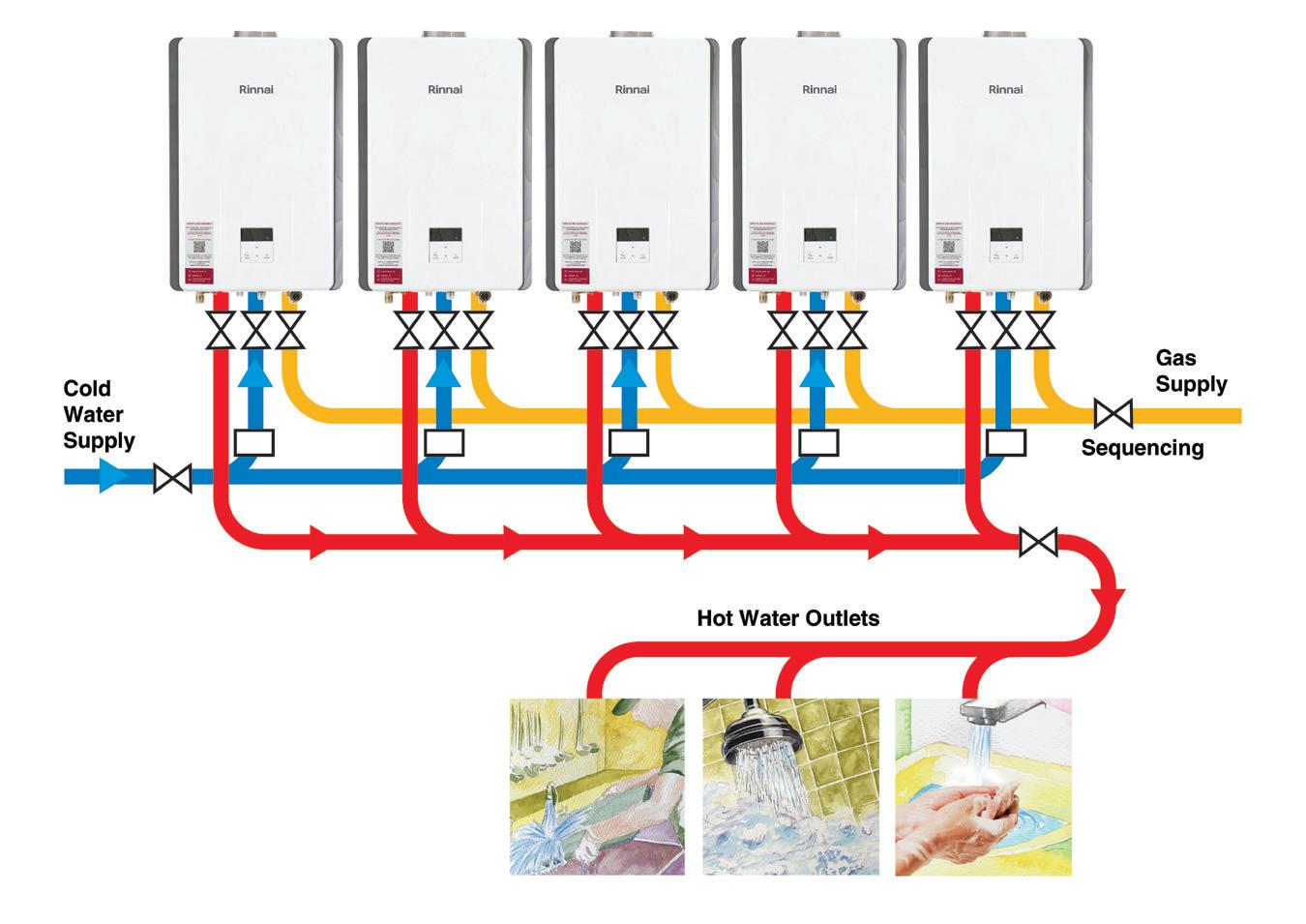
considers design from a holistic perspective of capital expenditure, operational expenditure, and carbon savings. Rinnai’s carbon calculation service will compare a customer’s current heating or DHW system to Rinnai’s product portfolio of low carbon, high performance, heating systems that are all proven to reduce cost. This feature will enable customers to view proven benefits when investing in a Rinnai system and understand the practical, technical, and economical benefits achievable from Rinnai system specifications.
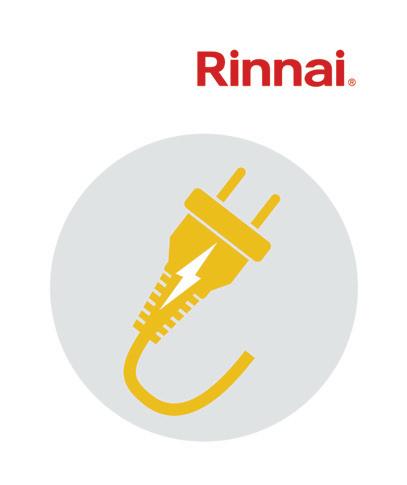
practical, economical and technically feasible.
A hybrid system would be an ideal option for projects looking to replace or upgrade their hot water system with a more energy efficient and cleaner solution. A hybrid system provides designers, property owners and managers with the familiarity of the continuous flow water heating system and renewable energy generated by a heat pump or solar thermal array.
Rinnai low-GWP range of heat pumps demonstrate Rinnai’s continuous dedication to producing low cost, highly efficient and thoroughly robust appliances that reduces operational expenditure and carbon emissions.
A hybrid (or dual fuel) heating system combines both a high efficiency continuous flow water heater or a hydrogen blend ready 20% water heater with a renewable heating system such as a heat pump or a Solar Thermal arrangement.
Widespread use of hybrid heating and hot water systems are increasingly relevant to the heating industry as the UK Government aims to reduce national reliance on fossil fuels. A hybrid system can meet all objectives in terms of being
Rinnai’s Hybrid solution is market leading technology owing to its ability to conserve energy. This is achieved by each gas fired water heater reading the temperature of the preheated hot water and modulating the gas input to boost required water temperature. This means that the renewable gains are maximised and the use of natural gas or hydrogen in the future is optimised. For more insights on Hybrid systems visit https://www. rinnai-uk.co.uk/products/commercial/ hybrid-heating-and-hot-water-2
Consultants, specifiers and contractors should seek manufacturers and suppliers with systems technology that is equipped with smart controls and adjusts performance on a constant basis in the drive to lowering carbon outputs yet retaining the need to create a healthier way of living.
HEAT PUMPS 29 ENERGY MANAGER MAGAZINE • MARCH 2024

FLEX YOUR ENERGY STRATEGY: A GUIDE TO FLEXIBLE PROCUREMENT
The energy market is notorious for its constant fluctuations. To remain ahead of energy bill uncertainties, businesses need to ensure that their energy strategy remains cost-effective and sustainable.
Northern Gas and Power, Europe’s largest energy consultancy, has taken on this challenge by developing a flexible energy procurement model that helps businesses navigate the everchanging market conditions. Flexible energy procurement, a dynamic approach to managing energy costs, is a powerful tool that allows businesses to take control of their energy bills, instead of being overwhelmed by them.
Discover how this strategy can be used to help you avoid surprising energy costs by reading our guide to flexible procurement.
UNDERSTANDING FLEXIBLE ENERGY PROCUREMENT
Flexible energy procurement is a tailored approach to purchasing energy that allows businesses to strategically manage their energy costs by capitalising on market opportunities and mitigating risks associated with market volatility.
Flexible Energy Procurement is an energy purchasing strategy that enables businesses to make purchasing decisions based on realtime market data and trends, allowing them to buy energy in tranches or blocks throughout the contract term. On the other hand, fixed energy procurement involved businesses being lock in a fixed price for their energy supply for the entire contract duration.
THE BENEFITS OF FLEXIBLE ENERGY PROCUREMENT
Flexible energy procurement empowers businesses to optimise their energy purchasing strategy, allowing them to capitalise on favourable market conditions and minimize overall costs. It enables companies to purchase energy in tranches, adjusting their strategy throughout the contract term to leverage market fluctuations effectively.
Another benefit is that, with access to market intelligence and real-time data, businesses can make informed purchasing decisions, reducing the impact of market volatility and mitigating risk. This proactive approach to energy procurement not only ensures cost savings but also enhances budget control and financial predictability.
Moreover, by monitoring usage data and market trends, companies can identify inefficiencies and implement
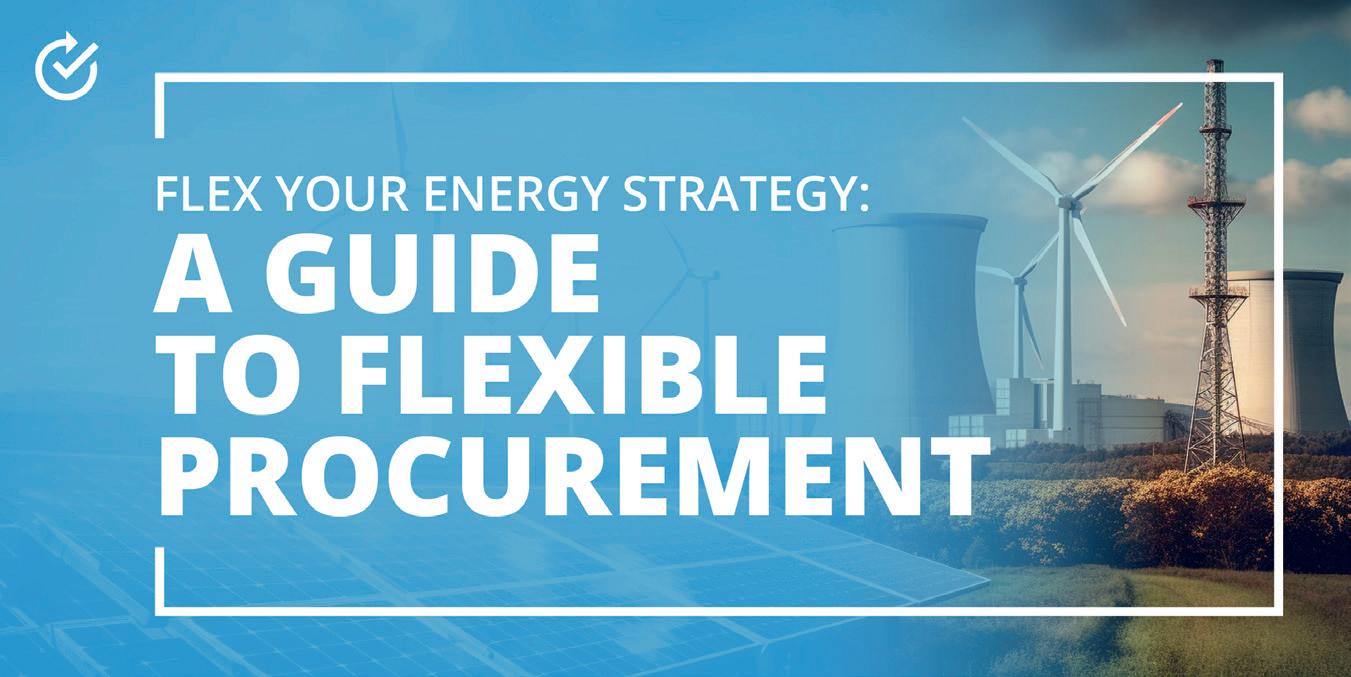
targeted improvements, leading to more sustainable energy practices. This holistic approach to energy management aligns financial goals with environmental objectives, fostering long-term sustainability and resilience.
Flexible energy procurement also inherently involves risk management, as businesses navigate the uncertainties of the energy market. With a strategic approach, companies can implement measures to manage potential risks, such as diversifying their energy sources, setting purchasing limits, and monitoring regulatory changes, ensuring they are better prepared for any unexpected market shifts.
HOW BUSINESSES CAN IMPLEMENT FLEXIBLE ENERGY PROCUREMENT
Implementing flexible energy procurement is a strategic process that requires careful planning and ongoing management. Here are some key steps businesses can take to adopt a flexible procurement approach effectively:
Before embarking on a flexible energy procurement journey, businesses must evaluate their energy requirements and determine their risk tolerance. This includes understanding their consumption patterns, industry-specific factors, and financial objectives. A thorough assessment provides a solid foundation for developing a tailored procurement strategy that aligns with the company’s goals and risk profile.
Collaborating with experienced energy consultants, such as our team at NGP, can provide valuable insights and support in developing and executing a customised flexible energy procurement
strategy. We help businesses understand market dynamics, identify opportunities, and manage risks effectively. By staying up-to-date and adapting their strategy as needed, companies can maximise the benefits of flexible energy procurement and ensure they remain resilient in the face of market volatility.
Since the start of the energy crisis, we’ve successfully helped almost 13,000 customers from all sectors navigate the challenges posed by market volatility. These businesses have been able to minimise the impact of fluctuating energy prices and secure their energy future through flexible procurement strategies. This is a testament to our expertise and commitment to delivering tailored solutions that meet the unique needs of each client, while also safeguarding their businesses against market uncertainties.
EMBRACE CONFIDENCE AND FLEXIBILITY
In an ever-evolving energy market, it is vital for businesses to adopt innovative and adaptable strategies to manage their energy costs, consumption, and risk effectively.
Flexible energy procurement offers a tailored and dynamic approach to help organisations confidently navigate market fluctuations, optimise energy consumption, and achieve long-term stability.
By partnering with experienced energy consultants like NGP, businesses can develop customised procurement strategies, leverage market intelligence, and implement effective risk management measures to secure their energy future. www.clearvue.business
30 ENERGY PROCUREMENT ENERGY MANAGER MAGAZINE • MARCH 2024

THE IMPORTANCE OF AUDITS: HOW TO EFFECTIVELY CONDUCT A PROCUREMENT AUDIT
Procurement fraud can be crippling for any organisation. In the past year, there has been a 13 percent rise in cases, collectively costing £136.6 billion in damages and lost business.
Audits are an inspection of a company’s financial situation that ensure procurement processes are secure, costefficient, and free of fraudulent activity – all of which are key in safeguarding current and future trading partnerships.
But why are procurement audits important? How can they lower risks and benefit organisations? And what is the best way to complete an effective audit process?
THE PROCUREMENT AUDIT EXPLAINED
Procurement audits review the entire procurement process from start to finish. This includes looking at supplier contracts, vendor history and current practices undertaken by managers and employees to spot red flags and anomalies in the supply chain and ensure current procurement processes add value to the business.
Procurement audits ensure contracts are being adhered to, mitigating complicated and unnecessary legal challenges.
THE MAIN OBJECTIVES AND BENEFITS
Procurement audits help businesses identify ways to achieve the most cost-effective trading relationships, quickly identifying contract or regulatory non-compliance and fraud before they happen.
Businesses reap several benefits from an effective procurement audit, such as:
1. Better spending – A key premise of procurement is to secure the most cost-effective partnerships where possible by staying up to date with market-related prices and frequently reviewing how money could be better spent.
When new suppliers enter the market offering more attractive pricing or unpredictable geo-political conditions cause a spike in prices, procurement audits enable organisations to identify opportunities for greater
Jack Macfarlane, Founder and CEO of DeepStream
cost-savings, which helps build financial health and stability.
2. Improved traceability and fraud prevention – With the prevalence of procurement fraud, traceability is key. Procurement audits allow organisations a plainer view of the entire supply chain, enhancing transparency and eliminating opportunities for fraud.
A key pillar of fraudulent behaviour is having the opportunity. If a company frequently invests in procurement audits, the risk of being caught becomes higher and instances of fraud are less likely to happen.
3. More efficient workflows –Legacy processes become outdated and new technologies allow businesses to streamline workflows, benefitting financial health. Without frequently auditing current practices, inefficiencies are identified too late or missed, resulting in missed cost savings.
Procurement audits allow businesses to identify where improved efficiency is needed, including targeted staff training, diversifying and increasing vendors, and removing outdated practices.
4. Reduced legal risk – Procurement is a complex business operation where legal challenges quickly arise if vendor contracts are breached or stringent government regulations and procurement standards are not met.
Audits create a digital paper trail, helping businesses remain compliant by regularly combing through contracts and regulations, avoiding the cost of legal challenges.
CONDUCTING AN EFFECTIVE PROCUREMENT AUDIT
An audit should be conducted by an appointed procurement team overseen by a dedicated incident manager. The incident manager is responsible for
ensuring the process is conducted correctly and transparently, ready to deal with any anomalies or problems identified.
A procurement audit should involve management from the get-go, ensuring any directives are implemented immediately without delays. Regular meetings must be held with every detail recorded and industry guidelines followed.

Identifying problem areas within the three main categories of procurement is the first step in an audit. These categories are contracts, processes and historical data, which are fundamental to procurement operations.
To mitigate legal risk and fraudulent activity, audit teams should dissect purchase order forms and store all supplier communications and contracts in a centralised digital platform, such as RFx software. Any suspicious activity should be quickly identified through the audit trail and promptly flagged.
Audit teams then review vendor selection processes to remove any chance of fraudulent activity happening, looking for an unusually small pool of vendors, inflated vendor prices, repeat selection of vendors and unlikely candidates winning contracts for example.
Lastly, all key insights should be compiled into a comprehensive report examining potential leads, oversights and red flags, detailing how these are going to be addressed, providing timelines and further suggestions to prevent similar problems in the future.
Procurement processes are complex and deal with vast quantities of data. It is paramount that there are at least four audits a year. However, a monthly procurement audit is the recommended industry best practice.
Together with routine audits, additional audits should be standard procedure in the event of any major business change, such as onboarding a new vendor or winning a new contract.
https://www.deep.stream/
31 ENERGY MANAGER MAGAZINE • MARCH 2024 ENERGY PROCUREMENT

GETTING TO NET ZERO
We’re in a race when talking about our climate challenge.
Ian
Rodger,
Director of Programmes, Salix Finance

The climate stability of the last 12,000 years has come to an end. Around the world we are seeing this impact today. It is a fact that northern latitudes are now warming faster than the equatorial and some southern regions.
Everyone must commit to net zero. We have no choice.
Collaboration between governments across the world, organisations, businesses and all of us will drive us towards net zero targets.
Collaboration is key.
At Salix our work is fundamental. Every part of our work will have an impact on the big picture. Our mission is to play a leading role in helping the public sector and housing transition to a low carbon future. Our work ensures Government funding is tackling decarbonisation and climate change, enabling action at a local level.
Our climate future is being made today. That is why everyone we speak to, whether it is across governments, or the public sector cannot go fast enough with this work.
We sense this urgency every day.
At Salix we began delivering the Public Sector Decarbonisation Scheme on behalf of the Government in 2020 and since then we’ve delivered more than £3bn worth of funding for this scheme on behalf of government.
More than 20,000 decarbonisation projects are now either operating or in development across the country thanks to this work.
In January 2023 we expanded beyond the public sector to take on housing. We were appointed Government delivery agent for Wave 2 of the Social Housing Decarbonisation Fund and Home Upgrade Grant.
Whether it is through the Social Housing Decarbonisation Fund, the Home Upgrade Grant, the Public Sector Decarbonisation Scheme, Low Carbon Skills Fund and Scotland’s Public Sector Heat Decarbonisation Scheme – our goals are the same.
Every day our teams are looking at complex decarbonisation technologies and how they will work within a particular environment. Together with organisations we discuss energy savings, cost savings, and explore multiple energy efficient measures which are unique to every site.
We’re on a mission to make homes and buildings more comfortable and healthier places to be in. We’re also very keen to visit projects to explore how people have been impacted by the decarbonisation works.
Recently our team visited Salisbury NHS Trust where patients are already seeing the impact of the major new energy efficiency works there.
Carers say the better environment is helping recovery rates. In addition to work completed, the Trust has plans to install 13 low carbon heat pumps to their District Hospital and has received funding from the Public Sector Decarbonisation Scheme.
The Trust already has an impressive set of solar PV panels. In just one building the solar panels have proved
20% more efficient than previous technologies, according to the Trust.
The hospital’s Green Plan maps out its carbon reduction objectives which supports the NHS goals to deliver a carbon net zero healthcare system by 2040.
Interim Deputy Head of Estates at the Trust Thomas Sneddon told us: “The Public Sector Decarbonisation Scheme Phase 3b funding has been a gamechanger for our Trust. It represents a substantial investment in our estate’s infrastructure – the largest in recent memory – and a major leap forward in our decarbonisation journey.”
Part of this success is because the Trust has embedded sustainability into its culture and processes. As well as introducing local carbon energy sources it has engaged with the wider community to create more energy efficient ways of working.
It’s fascinating to see how technology, ambition and collaboration are driving these projects at Salisbury.
Our housing work is growing by the day. When our Chief Executive Emma Clancy visited Greater Manchester Combined Authority (GMCA) to look at a Social Housing Decarbonisation Fund (SHDF) project being delivered by Six Town Housing in Bury she was impressed to hear how GMCA had retrofitted 870 homes under Wave 1 of the scheme. This brought them up to EPC band C or above. A further 5,481 homes are expected to be retrofitted under Social Housing Decarbonisation Fund Wave 2.1. This will make living conditions so much better for more Greater Manchester residents.
We’ve also been working with North York Moors National Park Authority.
National parks face huge net zero challenges.
The National Park Authority already collaborates with communities to support the sustainable management of moorland.
And to ensure it retains an abundance of species and habitats,
32 ENERGY FINANCE ENERGY MANAGER MAGAZINE • MARCH 2024
the Authority has placed climate change and nature recovery at the forefront of its vision for growth.
It was awarded funding under Phase 3a of the Public Sector Decarbonisation Scheme to help decarbonise two of its centres; Sutton Bank and Danby Lodge National Park Centres.
Project leaders were determined to replace a carbon emitting kerosene boiler with an air source heat pump.
The Sutton Bank project is now saving an estimated 42 tonnes of carbon annually and as well as being more energy efficient it will create a more comfortable environment for those using the venue.
It’s another case where ambition and collaboration are coming together to create a vision for the future.
When our Salix team recently visited Bristol City Council, we learned how significant changes to the way people work and commute had been influenced by ambitious green technology.
The council has installed various technologies across multiple sites including air source heat pumps and LED lighting. This is all part of the council drive to achieve their 2030 net zero target.
It was inspirational to visit the Bottle Yard Studios which has emerged as an example of environmental responsibility. Work here has included the installation of electrically powered radiant heating solutions and floor to ceiling insulation.
The installation of LED radiant heaters has meant that visiting production units no longer have to bring their own heating. The wall insulation has helped reduce heating loss by about 85%, according to the studios.
These are positive results and have set a good example to others.
We also visited the council’s Welsman Offices which has also benefited from the Public Sector Decarbonisation Scheme and expert support from Salix.
Public Sector Decarbonisation Scheme funding has helped pay for air source heat pumps, replacing
ENERGY FINANCE

the ageing gas boilers and removing the need for gas on site.
We were interested to hear from the council that the project has not only provided jobs but has upskilled contractors and addressed the long-standing heating issues. This is a huge result.
Furthermore, a new water source heat pump which replaced an outdated 15-year-old system has changed staff working habits. It has encouraged people to work from the office more often.
In fact, even commuter habits have changed with people cycling to work, knowing they can have a hot shower when they get there.
It’s as simple as that.
At Salix we have learned that through collaboration – and that means all of us as well as business and governments –we can make these changes happen.
To read more about the projects we work with, visit our website here: https://www.salixfinance.co.uk/


A wide group of people working across all areas of the Public Sector – to educate, train, support and connect as we work towards a more sustainable future.
33 ENERGY MANAGER MAGAZINE • MARCH 2024
www.pssa.info Join us today

HUGE CO2 EMISSIONS REDUCTION OPPORTUNITY WITH COMMERCIAL BUILDINGS RETROFIT FINANCE
• Commercial and public buildings are more energy intensive per m2 than residential property, making energy efficiency initiatives a high priority for meeting decarbonization targets.
• Yet, challenging economic times are causing investment
Retrofit for Purpose – a new insight study from Siemens Financial Services (SFS) –assesses the volume of carbon emissions buildings owners could save through energyefficiency-as-a-service schemes.
Specifically, the paper estimates emissions for the world’s four highestvolume emitter geographies – USA (71.35 MtCO2e), China (71.45), Europe (52.86), and India (14.91). Given these four areas are responsible for the majority of global CO2 emissions,1 this equates to more than 8% of global annual CO2 emissions reduction targets, as defined by the International Panel on Climate Change (IPCC).
Renovating existing building stock to a zero-carbon-ready level is a key priority for achieving the sector’s decarbonization targets. However, rising inflation, hardening interest rates, increased fuel costs, and supply chain disruption are all factors negatively impacting adoption rates. The report therefore evidences the enabling role of flexible private sector financing arrangements to maintain crucial investment momentum, drawing on many real-world examples of implementation from around the globe.
Comprehensive retrofits of commercial buildings – including offices, hospitals, factories, warehouses, and educational establishments – can reduce their energy use by up to 40 percent but are not happening anywhere near the scale needed to meet climate goals, notes the report. This is likely due to the considerable investment required to retrofit new technologies.
1 https://www.visualcapitalist.com/carbonemissions-by-country-2022/
in necessary retrofit technologies to slow.
• New research from Siemens Financial Services (SFS) estimates the volume of carbon emissions that could be reduced in the USA, Europe, China and India between now and 2030 through the wider deployment of
energy-efficiency-asa-service schemes.
• These flexible financing arrangements can secure operational cost reductions without putting pressure on capital resources, avoid putting capital at risk, and ensure expected savings are realized.
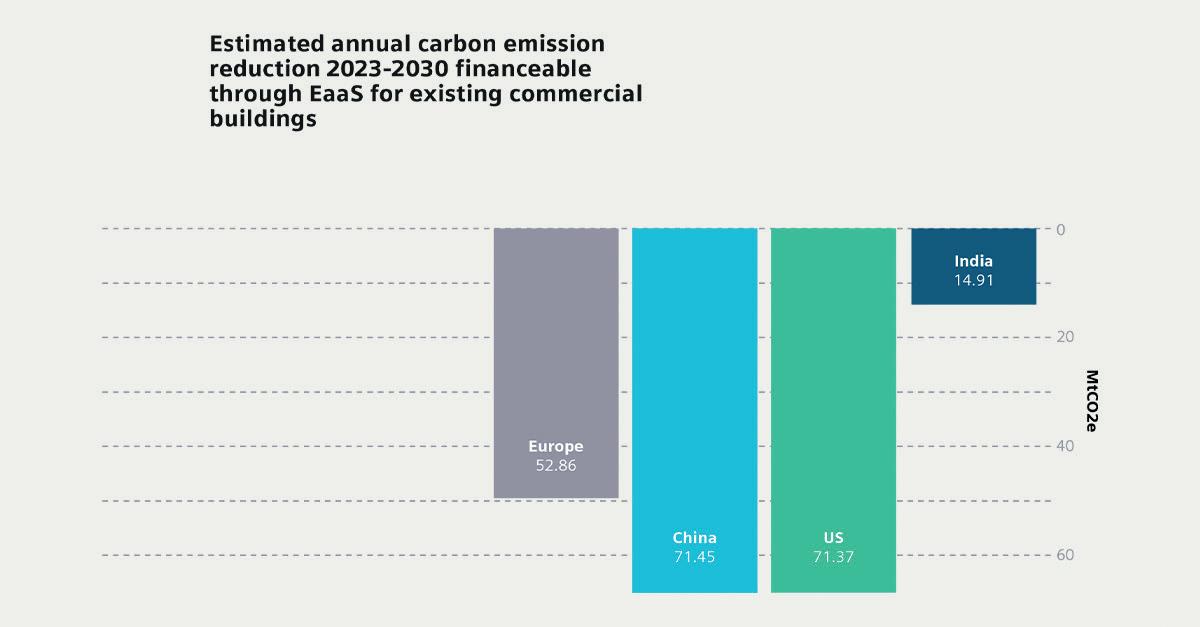
That’s where arrangements known as energy-efficiency-as-a-service are helping private and public sector organizations to retrofit the existing non-residential building stock in an affordable and cash-flow friendly way. These innovative financing schemes can secure operational cost reductions without putting pressure on capital resources, avoid putting capital at risk, and ensure expected savings are realized.
At the technology component level, financing tools are available to help vendors and distributors add value with cash flow capabilities for their buyers. For larger installations or systems, smart financing arrangements can be flexed and tailored to align costs with the rate of benefit gained from the energy-efficient technology.
“With climate targets looming large, it’s important we continue support and enable the decarbonization of buildings. Not only are they a serious contributor to global greenhouse gas emissions, if left unchecked these emissions are projected to double by 2050,” says Toby Horne,
Siemens Infrastructure Financing Partner, Siemens Financial Services, UK. “Specialist finance solutions are intelligently designed to factor in savings, making them budgetfriendly enablers of the green transition.”
METHODOLOGY
Data from national/regional statistical institutes on annual energy consumption by non-residential buildings built prior to 2010 was used to model CO2 emissions of buildings likely to benefit from deep retrofit for energy-efficiency. This was then reduced by highest likely implementation levels of such deep retrofit. Likely energy savings from deep retrofit were calculated using the lowest end of official average ranges. The resulting figures provide a highly conservative annual estimate of the energy savings achievable through deep retrofit, which can be financed through energy-efficiencyas-a-service financing techniques.
Download a copy of the Whitepaper: www.siemens.com/smart-buildingsretrofit For further information about SFS: www.siemens.com/finance
34 ENERGY FINANCE ENERGY MANAGER MAGAZINE • MARCH 2024

WE MUST RETROFIT OUR BUILDINGS TO MEET NET ZERO
Martin Fahey, Head of Sustainability at Mitsubishi Electric
The UK is now decarbonising all sectors of the economy as the country looks towards reaching Net Zero by 2050. The built environment currently makes a significant contribution to our overall carbon emissions, meaning it is a crucial area to tackle when striving to reach this goal.
The UK’s non-residential building stock contributes to almost a quarter of operational carbon emissions in the built environment, and it can therefore play an important role in reducing the environmental impact of our buildings in the coming years.
While in recent years there has been significant focus on ensuring these commercial spaces are constructed sustainably, around 80% of the buildings we will occupy in 2050 have already been built. This means we need to find ways of reducing the carbon footprint of the existing building stock now, if we are to reach these targets in future.
Low carbon retrofitting, where the systems providing heating, hot water and cooling are either upgraded or replaced to improve energy efficiency, offers a more straightforward, costeffective way of adapting these spaces in comparison to demolish and rebuild. This will help ensure our commercial buildings are operating sustainably, and in line with targets for Net Zero.
OUR BUILDINGS MUST BE ADAPTED NOW
The government is already introducing legislation designed to reduce the carbon impact of the built environment.
For example, the Minimum Energy Efficiency Standards (MEES) now requires all new and existing commercial buildings to have an energy performance rating of Grade E or above. These regulations are only set to tighten, with the government expected to commit to all buildings to be rated a minimum of Grade B by 2030.
The UK Net Zero Carbon Buildings Standard, developed by a group of leading industry organisations including RIBA and CIBSE, will also include performance targets for energy use, embodied and lifecycle embodied carbon in commercial buildings.
Investors are also beginning to take into account the green credentials of these spaces, while organisations continue to express an increased preference for leasing and purchasing more environmentally friendly buildings. This means buildings risk becoming ‘stranded assets’ and potentially becoming unlettable if they aren’t adapted to meet these regulatory requirements in the future.
LOW CARBON RETROFITTING IS THE ANSWER
While retrofitting our buildings to lower emissions can ensure they are operating in line with changing regulations, it can be difficult for building professionals to know where to start.
To meet this need, the UK Green Building Council has developed their ‘Delivering Net Zero: Key Considerations for Commercial Retrofit report. This outlines several key areas of consideration when embarking on a commercial retrofit project, starting with understanding the building and its specific requirements. This includes the greenhouse gas emissions associated with its operation and the performance of the systems installed.
Conducting a building assessment can then help identify any systems contributing to high carbon output, as well the scale of the project required. A light retrofit will only require adapting a specific aspect or building component, and so can be carried out while other areas are still in use. A deep retrofit involves making significant improvements or changes to building services, and may require a large-scale intervention such as change of occupancy. It’s therefore vital to plan for any potential limitations to retrofitting well in advance to minimise the amount of disruption caused.
Whole life carbon (WLC), the carbon emissions associated across a building’s entire lifecycle, is another important area to consider. This can help ensure the systems installed balance both operational (the carbon impact of the building being used) and embodied (the carbon used in construction and demolition) carbon, allowing the building to operate as efficiently as possible.

SELECTING THE RIGHT TECHNOLOGY IS CRUCIAL
Upon completing a building assessment, the next step is to opt for a solution that meets your building’s specific requirements.
A Hybrid Variable Refrigerant Flow (HVRF) system is able to provide quiet, energy efficient heating and cooling for a range of applications. The use of water as opposed to a refrigerant removes the need for leak detection in occupied spaces, reducing ongoing maintenance costs while also future-proofing buildings against upcoming changes to the F-Gas regulations. Its decentralised structure can also support a phased installation approach while the number of units can be expanded to meet demand, making it ideal for owners and managers wanting to minimise disruption to occupants.
Installing a heat pump can also improve the energy efficiency of your building. High temperature heat pumps such as the 40kW Ecodan QAHV can deliver hot water of up to 90°C, while lowering carbon footprint and providing significant cost savings. Owners and managers adopting a phased-out approach can also consider opting for a bivalent heat pump system, where the heat pump and gas boiler work in parallel but the former provides a higher proportion of heating to lower a building’s overall carbon emissions.
With buildings owners and managers increasingly having to adapt their spaces in line with changing environmental regulations, it is imperative the commercial sector is not left behind. By retrofitting these spaces with low carbon, energy efficient technologies, we can ensure these buildings are prepared to hit the government’s ambitious, but very necessary, Net Zero goal.
https://les.mitsubishielectric.co.uk/
35 ENERGY MANAGER MAGAZINE • MARCH 2024 NET ZERO

RINNAI GOES ELECTRIC ON WATER HEATING PRODUCTS TO EXISTING NATURAL GAS, HYDROGEN BLENDS READY AND BIOLPG UNITS
Now available from Rinnai are electric additions to the comprehensive range of heating and hot water heating systems and units. UK energy strategists believe that clean and sustainable electrification is presently one of the best modes of reducing carbon emissions, maximise efficiencies and to also lower end-user customer costs.
Rinnai has, therefore, adapted its extensive product range to include electric versions and to develop modern technologies in offering continuous flows of product innovation. More new launches are expected in the first part of this year.
Rinnai’s Infinit-E range is an optional three-phase all-electric water storage heater for commercial hot water applications. All electric storage water heaters are designed with flexibility in mind. All units are fitted with between one and six titanium elements. The KW rating within the Infinit-E range is scalable from 12kw to 72kw ensuring that our appliances are suitable for a wide variety of applications.
Each cylinder is manufactured with stainless steel adding durability and enabling extensive warranties. The use of stainless steel also makes the Infinit-E range lightweight and easily manoeuvrable when compared to glass-lined variants. The empty weight of the Infinit-E is 54kg maximum.
All electrical elements can be fitted to a single-phase supply, should site limitations dictate. Each element within the appliance range has its own controllable thermostat with a temperature range of between 49 and 90 degrees Celsius. All elements are fuse protected and there is no need for expensive sacrificial anodes due to a tough stainless-steel build.
All-electric systems can benefit from our modulating smart electric cylinder range – ensuring that the only direct electricity used is to fill the performance gap from the renewable heat source. Rinnai’s electrical hybrid solar heating and hot water systems deliver identical performance when compared to traditional options.
Rinnai’s range of electric products include monobloc air source heat pumps that are available in an assortment of variants, from 4kW to 110kW. Rinnai’s heat pump technology ensures that up to and including seven units can be cascaded together. A cascaded system means that multiple heat pumps can work in conjunction allowing for a level of functioning synchronicity that produces greater operational performance for larger commercial applications.
The HPI models omit minimum acoustics via an installed ultra-low sound capability making Rinnai heat pumps suitable for any area with prohibitive sound legislation. Rinnai’s HPI range operates within compliance of all stringent sound standards ensuring low-sound functionality.
All Rinnai commercial heat pumps use LOW-GWP including R32 and R290, renowned for reducing electricity consumption by up to 10% and for holding a lower global warming potential (GWP). Rinnai’s HPI heat pump range is ratified with an ERP rating of A +++ and includes an operational ability to switch between settings of heating, hot water, and cooling.
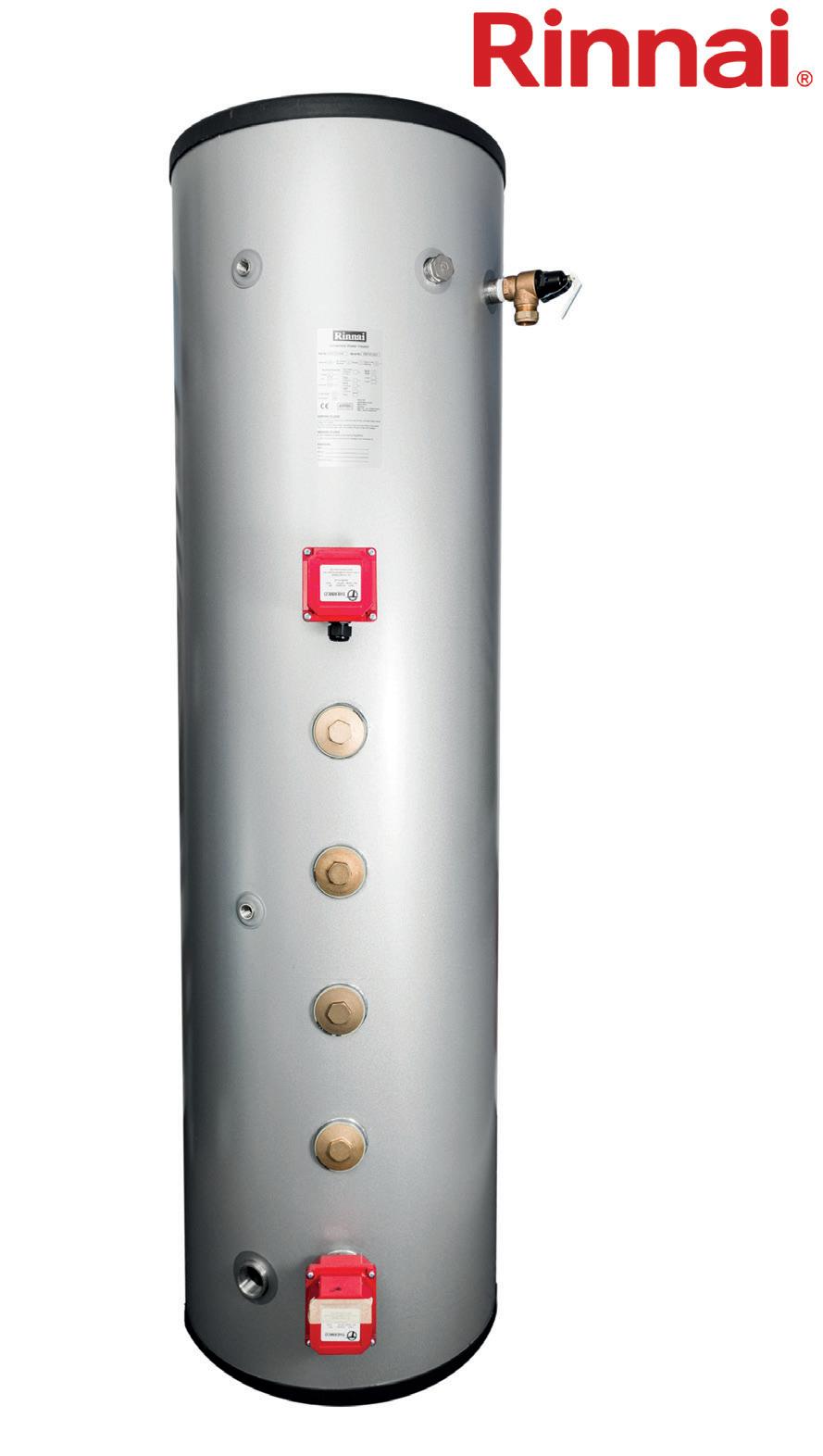
Rinnai’s HPI air source heat pumps, hybrid formations, electrical formats and hydrogen gas mix powered water heaters are part of the H3 range of products. All new models are designed to embolden decarbonisation, energy efficiency and reduce customer costs by offering practical, affordable, and feasible solutions to all UK customers.
Rinnai is determined to offer UK customers assorted options of carbon reducing technology that ensures an improved healthy lifestyle. Rinnai is also keen on informing all UK customers
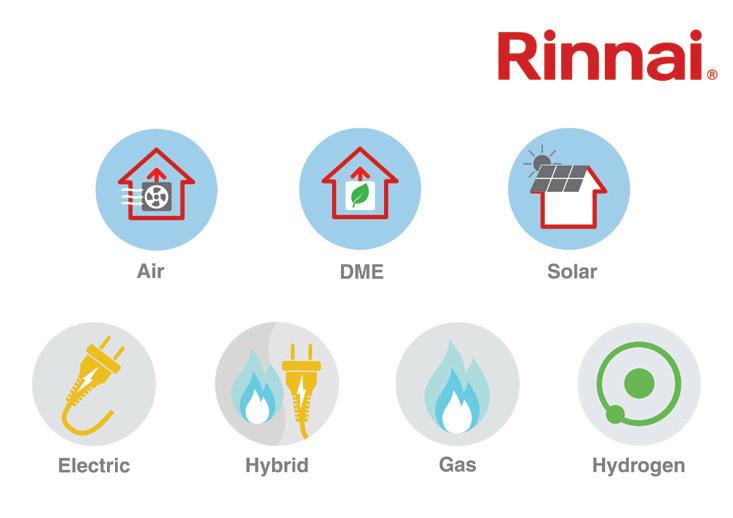
in major changes and developments concerning the international energy market that may affect purchase or power options in the near and far future. For the latest blog and vlog information on products and policy visit www.rinnaiuk.com and subscribe to the Rinnai newsletter.
36 HEATING ENERGY MANAGER MAGAZINE • MARCH 2024

HEAT NETWORK REGULATION CHANGES –WHAT YOU NEED TO KNOW
With only a year until Ofgem officially steps into the role of regulator for Britain’s heat network sector, it’s no exaggeration to say the industry is entering a new era. The days when heat network operators were less strictly regulated than gas and electricity suppliers are numbered. In future, we can expect to see a lot more attention paid to customer protection, and this inevitably means more scrutiny for energy providers.
Legislation defining the new market framework is expected to be fully phased in by 2026. The precise details aren’t yet known as Ofgem is still consulting with stakeholders across the industry to ensure the new rules are relevant, effective, and appropriately implemented.
ENHANCED CONSUMER PROTECTION
What we do know is that the first phase of the roll-out in Spring 2025 will include measures covering information transparency, metering, and safeguards for vulnerable customers. Citizens Advice will be appointed to provide consumer advocacy and the Energy Ombudsman will offer dispute resolution services.
Ofgem will also start collecting operational and financial data from registered heat suppliers next year, before implementing pricing rules and Guaranteed Standards of Performance (GSOPs) in 2026. Heat suppliers that fail to comply with these may have to pay compensation to affected consumers.
BACK TO NORMAL ENERGY PROCUREMENT PROCESSES
Another important change will be the closing of the Energy Bills Discount Scheme (EBDS) on 31st March 2024, which is not expected to be replaced. So, it’s back to business as usual for incoming fuel tariffs. However, factors such as current conflicts in the Middle East and Ukraine mean ongoing market stability is far from guaranteed, and that should be borne in mind when entering into new contracts with energy suppliers.
So, what does all this mean in practice, and what steps should energy managers take now to prepare for the road ahead?
1. Check your meters – Effective metering will play a crucial role in ensuring your organisation can

meet its new regulatory obligations. Meters should be replaced by smart meters where possible. They should also be included in regular maintenance regimes and replaced when they near the end of their expected life. If they fail, bills will be inaccurate, leading to residents being over- or undercharged, and making it difficult to manage heat network financials. Meters can also help to identify any abnormal consumption levels so you can keep your heat network functioning optimally to keep costs down for residents. And they can provide households with real-time energy usage data in line with transparency requirements.
2. Keep on top of tariffs – Incoming tariffs may well continue to change relatively frequently, so you should conduct regular reviews to ensure residents are charged correctly. Under the new regulations, they are expected to require 31 days’ notice of any price changes, plus any back-billing will be limited to 12 months in most circumstances. Tariff changes often coincide with supplier changes, so setting a diary notification eight weeks before contract transitions will allow for proactive adjustments to be made. Involve your metering and billing provider as early as possible to ensure correct billing coordination. This is also a good time to confirm with residents any access agreements needed for meter-fault repairs, especially where they are vulnerable.

3. Keep communicating –Cooperation and communication will be vital to help ensure your residents understand how the new regulations will affect them and what their responsibilities are. This is also a ‘good-news’ opportunity that could help to strengthen relationships – the legislative changes are designed to benefit them, after all.
Keep talking to your suppliers, too. Notify them of any contract changes and lean on the ones with heat network expertise to help you prepare for the new regulations, reduce costs, and get the most out of your equipment. Don’t wait until you’re hit with a big bill or a fine to find out there’s a problem.
With tariff change notice periods for residents needing to be factored into timescales and potentially new processes needing to be set-up to allow for data transparency, energy managers should act now to check they’re following best-practice guidelines.
Help is available, however. Your metering & billing and/or maintenance suppliers should be aware of what’s coming and willing to help you prepare.
www.insite-energy.co.uk
37 ENERGY MANAGER MAGAZINE • MARCH 2024 HEAT NETWORKS

ONSITE GENERATION: MAKING IT WORK FOR BUSINESS

In this article, Jodie Eaton, CEO of Shell Energy UK, explores the opportunities presented by onsite energy generation and provides guidance to help major energy users make the right decisions, when it comes to investing and making progress towards long-term objectives.
As major energy users look to build resilience, better manage risk and take a tighter control of costs, onsite generation is becoming increasingly attractive as part of a wider portfolio of energy solutions. According to a recent survey of energy-intensive businesses in the UK, the majority are already investing in managing energy demand.
In fact, more than half of the businesses surveyed reported investing in ways to control energy demand, with 45% already engaged in onsite generation initiatives.1 So, what are the options, how can it fit in to wider decarbonisation plans, and what support do businesses need?
Increasing onsite renewables is also a priority for the Government’s new Solar Power Taskforce2 which set out its plans to drive take-up of more rooftop solar on commercial sites in line with targets to increase solar capacity nearly fivefold, to 70GW by 2035.
WHAT IS ONSITE ENERGY GENERATION?
As the name suggests, onsite energy generation is the name given to power generated at a particular location, rather than purchased from the grid. In the UK, the most common onsite energy generation solution is rooftop solar, but small-scale wind power generation is also possible depending on available space.
Energy generation often goes handin-hand with energy storage, such as batteries or even vehicles, with businesses able to sell any excess energy unable to be stored back to the grid. While on-site storage is currently the least used carbon
1 Shell Energy surveyed 100 decision makers in energy-intensive businesses (June 2023)
2 ‘Untapped potential’ of commercial buildings could revolutionise UK solar power - GOV.UK (www.gov.uk)

reduction strategy,3 it is widely considered the number one priority for the future –with nearly half of businesses surveyed currently planning or trialling this solution.
For businesses that have a high operational demand for energy. investing in onsite generation can be an attractive option. Not only can it be more cost effective, but when combined with storage solutions, it can also improve supply resilience by reducing dependence on the grid.
WHAT DO BUSINESSES NEED TO CONSIDER BEFORE INVESTING IN ONSITE GENERATION?
More than half of the businesses we surveyed were committed to controlling and managing demand. The adage that the cheapest unit of energy is the one you don’t use is as relevant as it has always been, and a combination of volatile energy prices and supply security concerns have pushed energy higher up the list of operational concerns.
When considering investing in onsite energy generation, understanding your current and future energy needs and how well your demand is optimised will be crucial to making the right choices for your business, helping you scope the size and type of generation asset best suited to you.
The technology you decide on for onsite generation will very much depend on the unique needs of your business, so research is vital – as is seeking expert advice. Most of the companies we surveyed (60%) work with their energy suppliers to unpick the options and ensure their investment is well placed and will deliver against their long-term objectives.
Options that will also deliver decarbonisation benefits include solar panels and heat pumps, with some potential
3 Shell Energy surveyed 100 decision makers in energy-intensive businesses (June 2023)
for anaerobic digestion and wind power. The pros and cons of each need to be thoroughly investigated and then aligned to priorities.
A feasibility study if you are considering rooftop solar for example, will help to determine exactly how much energy you can generate and store on site and how much that delivers against overall requirements.
For larger businesses, the drivers can range from compliance with regulatory decarbonisation targets, resilience and self-sufficiency in energy (if supply is compromised), or sometimes businesses are purely looking at long-term energy cost savings. Each priority will favour different options. It’s also important to gain a full understanding of any limitations a potential solution may have as well, so you know exactly what to expect from your investment.
Another factor that businesses need to consider is how they will fund investment into onsite generation. The business case is vital to get board level buy-in. You need to factor in the potential for reducing energy costs, how such investment can mitigate the potential risks of outages and the implications of that, and how such an investment will help to achieve business decarbonisation goals.
For those companies that decide that they can’t currently commit to onsite generation for practical or cost reasons, there remains the option to invest in power purchase agreements (PPAs), where you buy renewable energy from an asset built by a third party. This option has the potential to deliver reductions on energy bills, as well as measurable decarbonisation benefits.
MAKING THE RIGHT DECISION
Expert advice is available from the Shell Energy team, who can provide guidance for your business in reaching its decarbonisation goals. For more information, visit www.uk.shellenergy.com.
38 ON-SITE GENERATION ENERGY MANAGER MAGAZINE • MARCH 2024
CARBON ACCOUNTING

WHAT METHOD SHOULD YOU USE FOR CARBON ACCOUNTING?
Just as organisations use financial accounting to establish the facts about their business activities, they’re increasingly using carbon accounting to quantify their environmental impact. There may soon be legal requirements for organisations to report their carbon emissions in standardised ways. Here, we examine carbon accounting reports and discuss the advantages and disadvantages of some of the most widely used methodologies at present.
What is carbon accounting?
Carbon accounting is the process of quantifying the amount of greenhouse gases (GHGs) produced by an organisation’s activities. It’s also sometimes known as greenhouse gas accounting.
Calculating an organisation’s emissions (or carbon footprint) involves reporting on the Scope 1, 2 and 3 emissions. These are defined by the GHG Protocol (GHGP).
What principles apply to carbon accounting?
Just as your organisation’s financial accounts provide a ‘faithful, true and fair’ account of your business performance, your carbon accounts should do the same for your carbon or GHG emissions.
To ensure this, the Greenhouse Gas Protocol requires that carbon or GHG accounting follows these five key principles:
• Relevance: Your carbon accounts must contain the information other stakeholders – inside and outside the organisation – need to make decisions.
• Completeness: You should always

strive to give the most complete and accurate account of your organisation’s emissions possible. You should explain any exclusions.
• Consistency: Your accounting should enable comparison of the amount of carbon emissions produced over time.
• Transparency: Disclose emissions in a neutral and factual way. You should explain what methodology you are using. Many organisations call on third parties to verify their carbon accounting.
• Accuracy: The data your organisation shares should always be accurate and credible.
What are the three main methods of carbon accounting?
Most organisations use one of three methodologies to produce their carbon accounts:
1. Spend-based methodology –This takes the value of the individual goods or services that your organisation has purchased during the accounting period. It then multiplies it by an agreed ‘emission factor’ to quantify your carbon emissions.
Industry-wide averages of the levels of emissions associated with a particular activity derive these “emission factors”. One advantage of the spend-based method is that it provides organisations with a clear estimation of emissions associated with each financial unit. However, that estimation is based on averages. It may suffer from inaccuracies when used to calculate your organisation’s precise emissions.
2. Activity-based methodology –Activity-based carbon accounting quantifies your organisation’s emissions based on the activities it carries out. It depends on collecting emissions data from the entire length of your value chain. Because it’s based on granular data rather than averages, it makes it possible to provide a more accurate representation of your organisation’s carbon emissions. However, it may be difficult to find all the data you need to cover Scope 3 emissions using this approach.
3. Hybrid methodology – The Hybrid approach allows your organisation to enjoy the advantages of both the spend-based and activity-based methodologies. You need to gather all the granular data that can be harvested from the length of your value chain. Then, use spend-based methodology to ‘fill in’ any gaps that may be left. For instance, for some of your Scope 3 emissions. It allows your organisation to accurately account for its carbon emissions.
HOW TO CHOOSE THE RIGHT CARBON ACCOUNTING METHOD FOR YOUR ORGANISATION
Every organisation faces different challenges. Choosing the right methodology to account for your carbon emissions depends on your organisation’s particular needs and goals. It also depends on what field your organisation works in, and the length of your value chain.
Consider all three methodologies in the context of your organisation and the reality in which you work. You also need to consider any compliance and reporting standards that affect your organisation.
Importantly, you’ll also need to adopt a method that suits both the data and the resources you have available. If you lack granular data for some of your emissions, then it’s far better to choose the spendbased or hybrid approach to carbon accounting than no approach at all.
Finally, whichever methodology you choose to adopt, you’ll need to communicate the reasons for your choice with all your stakeholders. That way, you’ll have a better chance of achieving the buy-in you need.
NEED MORE HELP WITH CARBON ACCOUNTING?
At Drax, we’ve got the expertise to help you with your organisation’s carbon accounting. And in collaboration with our partner, CBN Expert, we’re able to offer comprehensive carbon accounting for your organisation, plus free net zero training worth £2,500.
https://energy.drax.com/net-zero
39 ENERGY MANAGER MAGAZINE • MARCH 2024
London
https://meucnetwork.co.uk/events/spring-conf24/
Calling all Large Energy and Water Users
This premier event, brings together industry experts, policy makers, and major energy users to explore the latest trends, innovations, and strategies in utility management.
Why Attend?
Insightful Content: Learn from industry leaders.
Networking Opportunities: Connect with peers and experts.
Actionable Strategies: Leave with practical knowledge.
Don’t miss out on the opportunity to learn, connect, and collaborate with other professionals in the energy and water industry. Secure your place today.


event supporters:

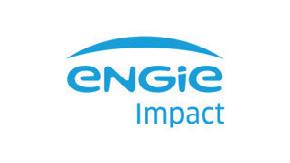


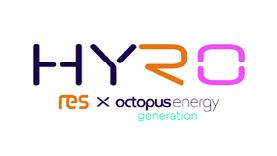
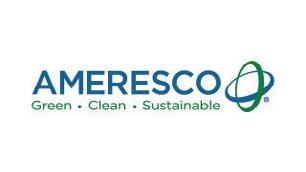




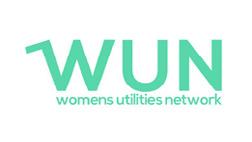









event partner:


Buying and Using Utilities LIVE | 25 April 2024
Savoy Place,
IET,
MEUC Ltd. | meucnetwork.co.uk | enquiries@meucnetwork.co.uk | 020 3432 0333
powered by:































































































































